-
 Lake Quannapowitt from Church Street, Wakefield, Mass.
Lake Quannapowitt from Church Street, Wakefield, Mass. Postcard shows a view of Lake Quannapowitt from Church Street on the southern shore.
-
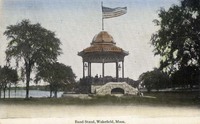 Band stand, Wakefield, Mass.
Band stand, Wakefield, Mass. Postcard shows a view of the bandstand on the Common, built in 1885 at a cost of $2,500 as a replacement for an earlier wooden bandstand. The new bandstand was also known as the Pagoda and the Music Pavilion.
-
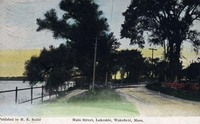 Main Street, lakeside, Wakefield, Mass.
Main Street, lakeside, Wakefield, Mass. Postcard shows a view of the lakeside on the eastern shore of Lake Quannapowitt.
-
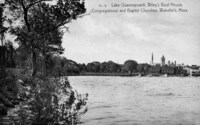 Lake Quannapowitt, Wiley's boat house, Congregational and Baptist churches, Wakefield, Mass.
Lake Quannapowitt, Wiley's boat house, Congregational and Baptist churches, Wakefield, Mass. Postcard shows a view from the eastern shore of Lake Quannapowitt toward the Common.
-
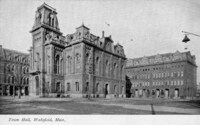 Town Hall, Wakefield, Mass.
Town Hall, Wakefield, Mass.
-
 North End of Crystal Lake from Hart's Hill Tower, Wakefield, Mass.
North End of Crystal Lake from Hart's Hill Tower, Wakefield, Mass. Postcard shows a view over Crystal Lake looking north from the top of Hart's Hill. Main Street is visible in the foreground. On the far shore the Crystal Lake water filtration plant can be seen. At the upper right the buildings of the Harvard Knitting Mills complex are visible.
-
 The Rockery, Wakefield, Mass.
The Rockery, Wakefield, Mass. Postcard shows the Rockery on Main Street, looking north toward the Common.
-
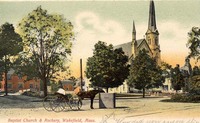 Baptist Church & Rockery, Wakefield, Mass.
Baptist Church & Rockery, Wakefield, Mass. Postcard depicts a view northwest across Main Street towards the Baptist Church. The Rockery and High School (now Town Hall) are also visible.
-
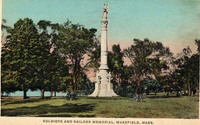 Soldiers and sailors memorial, Wakefield, Mass.
Soldiers and sailors memorial, Wakefield, Mass. Postcard shows the Soldiers and Sailors Memorial on the lower common, erected in 1902 to commemorate Wakefield's Civil War casualties.
-
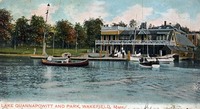 Lake Quannapowitt and park, Wakefield, Mass.
Lake Quannapowitt and park, Wakefield, Mass. Postcard shows Wiley's boat house on the shore of Lake Quannpowitt on Wakefield Common at the end of Spaulding Street.
-
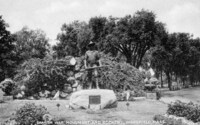 Spanish war monument and Rockery, Wakefield, Mass.
Spanish war monument and Rockery, Wakefield, Mass. Postcard shows the Rockery on Main Street, looking north. The statue known as "The Hiker", by Theo Alice Ruggles Kitson, was dedicated on October 12, 1926 in honor of Wakefield citizens who took part in the Spanish-American War.
-
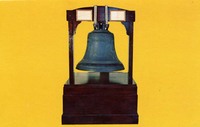 [Paul Revere bell]
[Paul Revere bell] Postcard shows the large "Paul Revere bell", formerly on display at the Lucius Beebe Memorial Library. The bell is famous in town because it was made by the firm of Paul Revere. The work was probably done by his son, Joseph, but the bell is considered an original Revere bell because it was cast during his lifetime. The bell, weighing "about eight hundred and fifty weight", was purchased in 1815 by the town of South Reading for the parish for $350. The bell was hung in steeple of the First Parish Congregational Meeting House. In 1859 it was moved to the cupola of the Town's meeting hall on Church Street. The town hall was moved in 1871 to the corner of Main and Salem Streets and the bell moved with it. In 1888 is was moved to the new High School, what is now the William Lee Memorial Town Hall (Lafayette Building). In 1930 the bell was relocated to the lower lobby of Beebe Library, and in 1973 was brought up to the main floor lobby in the historic part of the building. The bell was transferred to the Wakefield Savings Bank during the Library's renovation and reconstruction in 1997. Later, it was moved to the lobby of the Galvin Middle School, where it remains today.
-
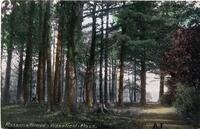 Rosson's Grove, Wakefield, Mass.
Rosson's Grove, Wakefield, Mass. Postcard shows Rosson's Grove, located at the northern end of Lake Quannapowitt.
-
 Interior view of St. Joseph's church, Wakefield, Mass.
Interior view of St. Joseph's church, Wakefield, Mass. Postcard shows the interior of St. Joseph's Church at the corner of Albion and Tuttle Streets. The building was destroyed by fire on March 24, 1977.
-
 Harvard Knitting Mill, Wakefield, Mass.
Harvard Knitting Mill, Wakefield, Mass. Postcard depicts the Harvard Knitting Mill complex looking south from the corner of Albion and Foundry Streets.
-
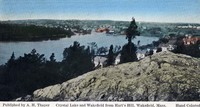 Crystal Lake and Wakefield from Hart's Hill, Wakefield, Mass.
Crystal Lake and Wakefield from Hart's Hill, Wakefield, Mass. Postcard shows a view of Crystal Lake and Wakefield looking northwest from the top of Hart's Hill.
-
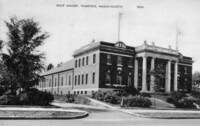 State armory, Wakefield, Massachusetts
State armory, Wakefield, Massachusetts Postcard shows the Massachusetts State Armory on Main Street at the corner of Armory Street. The building was dedicated on January 15, 1913. In 1975 the town of Wakefield purchased the armory from the state for one dollar. It is now known as the Americal Civic Center and operated by the Americal Civic Center Association.
-
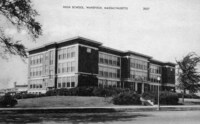 High School, Wakefield, Massachusetts
High School, Wakefield, Massachusetts Postcard shows a view of Wakefield High School on Main Street at the location of the current Galvin Middle School parking lot. The building was opened in 1923 and was later known as the Atwell building in honor of Superintendent of Schools Willard B. Atwell. It was destroyed by fire on December 12, 1971.
-
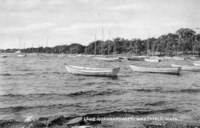 Lake Quannapowitt, Wakefield, Mass.
Lake Quannapowitt, Wakefield, Mass. Postcard shows a view of pleasure boats on Lake Quannapowitt, looking north up Main Street from the Common.
-
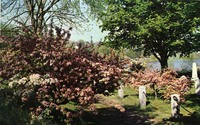 Floral Way, Lake Quannapowitt, Wakefield, Mass.
Floral Way, Lake Quannapowitt, Wakefield, Mass. Postcard shows a view of the Floral Way, an arbored walkway roughly 800 feet long on the south shore of Lake Quannapowitt between the Old Burying Ground and the Hartshorne House. The Floral Way was planted in 1949, mostly with flowering crabtrees, as a living memorial to the town's servicemen and women of all wars.
-
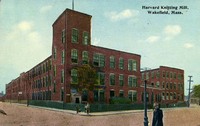 Harvard Knitting Mill, Wakefield, Mass.
Harvard Knitting Mill, Wakefield, Mass. Postcard depicts the Harvard Knitting Mill complex looking south from the corner of Albion and Foundry Streets.
-
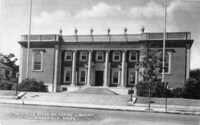 Lucius Beebe Memorial Library, Wakefield, Mass.
Lucius Beebe Memorial Library, Wakefield, Mass. Postcard shows the Lucius Beebe Memorial Library after opening in 1923.
-
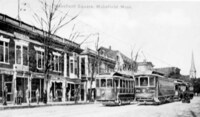 Wakefield Square, Wakefield, Mass.
Wakefield Square, Wakefield, Mass. Postcard shows the west side of Wakefield Square looking north up Main Street from Richardson Avenue to the Baptist Church. Electric streetcars, which were discontinued in the early 1930s, are visible.
-
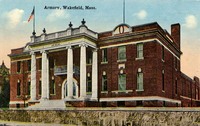 Armory, Wakefield, Mass.
Armory, Wakefield, Mass. Postcard shows the Massachusetts State Armory on Main Street at the corner of Armory Street. The building was dedicated on January 15, 1913. In 1975 the town of Wakefield purchased the armory from the state for one dollar. It is now known as the Americal Civic Center and operated by the Americal Civic Center Association.
-
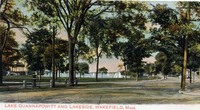 Lake Quannapowitt and lakeside, Wakefield, Mass.
Lake Quannapowitt and lakeside, Wakefield, Mass. Postcard shows a view of Lake Quannapowitt, and the upper common, including the bandstand, looking north from the corner of Main and Pearl Streets.
-
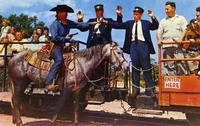 Great train robbery at Pleasure Island
Great train robbery at Pleasure Island "On every trip of the Pleasure Island and Western Railroad, attempts are made by armed bandits to board the train to rob passengers and the conductor. They never succeed because the trusty sheriff riding on the train guns them down. (At Pleasure Island, Wakefield, Mass., on Route 128, Exit 21-A, just 14 miles North of Boston" -- Text from back of postcard.
-
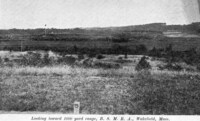 Looking toward 1000 yard range B.S.M.R.A., Wakefield, Mass.
Looking toward 1000 yard range B.S.M.R.A., Wakefield, Mass. Postcard shows 1000 yard rifle range at Camp Plunkett, home of the Bay State Rifle Association. The Camp was purchased from them in 1926 by the Commonwealth of Massachusetts, and the name changed to Camp Curtis Guild. It is now home to the Massachusetts National Guard.
-
 Camp Curtis Guild
Camp Curtis Guild Postcard shows rifle practice at Camp Curtis Guild, formerly Camp Plunkett. The Camp was purchased from the Bay State Rifle Association in 1926 by the Commonwealth of Massachusetts. It is now home to the Massachusetts National Guard.
-
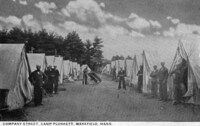 Company Street Camp Plunkett, Wakefield, Mass.
Company Street Camp Plunkett, Wakefield, Mass. Postcard shows rifle practice at Camp Curtis Guild, formerly Camp Plunkett. The Camp was purchased from the Bay State Rifle Association in 1926 by the Commonwealth of Massachusetts. It is now home to the Massachusetts National Guard.
-
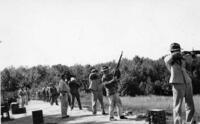 Camp Curtis Guild
Camp Curtis Guild Postcard shows rifle practice at Camp Curtis Guild, formerly Camp Plunkett. The Camp was purchased from the Bay State Rifle Association in 1926 by the Commonwealth of Massachusetts. It is now home to the Massachusetts National Guard.
-
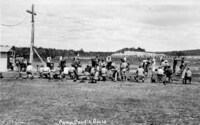 Camp Curtis Guild
Camp Curtis Guild Postcard shows rifle practice at Camp Curtis Guild, formerly Camp Plunkett. The Camp was purchased from the Bay State Rifle Association in 1926 by the Commonwealth of Massachusetts. It is now home to the Massachusetts National Guard.
-
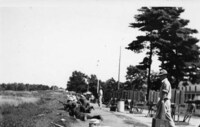 Camp Curtis Guild
Camp Curtis Guild Postcard shows rifle practice at Camp Curtis Guild, formerly Camp Plunkett. The Camp was purchased from the Bay State Rifle Association in 1926 by the Commonwealth of Massachusetts. It is now home to the Massachusetts National Guard.
-
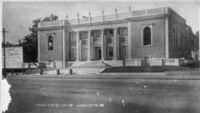 Beebe Public Library
Beebe Public Library Postcard shows the Lucius Beebe Memorial Library during construction. the new library opened in 1922.
-
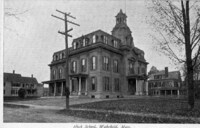 High School, Wakefield, Mass.
High School, Wakefield, Mass. Postcard shows the High School on Wakefield Common at Lafayette Street. Built in 1871, the building was used for school purposes until 1937, when it was remodeled as part of a WPA project for municipal offices. The building, also known as the Lafayette building, is now Wakefield's Town Hall.
-
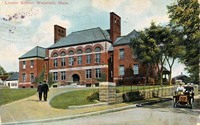 Lincoln School, Wakefield, Mass.
Lincoln School, Wakefield, Mass. Postcard shows the Lincoln School at the corner of Crescent and Otis Streets. The school was built in 1892 and is now used for elderly housing.
-
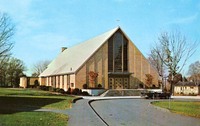 St. Florence's Roman Catholic Church, Butler Avenue, Wakefield, Mass.
St. Florence's Roman Catholic Church, Butler Avenue, Wakefield, Mass. Postcard shows St. Florence's Church on Butler Avenue. The building was completed in 1960.
-
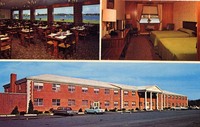 Lord Wakefield Motor Hotel
Lord Wakefield Motor Hotel "Lord Wakefield Motor Hotel, At Exit 35, Route 128, Wakefield, Mass., Tel. 617-245-6100. Colonial decorated lakeview dining room, coffee shop, and new Cypress Cove cocktail lounge augment the 92 fully carpeted, air-conditioned bedrooms. Spacious parking and a crystal clear swimming pool add to your pleasure at this modern AAA recommended hostelry." - Text from back of postcard.
-
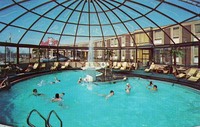 Colonial Hilton Inn
Colonial Hilton Inn "Colonial Hilton Inn, Exit 31 and 32, Rte. 128, Wakefield, Massachusetts, Tel.: 617-245-9300. New England's most spectacular motor inn featuring 180 luxurious rooms and suites. Year 'round glass enclosed pool, health club, 18 hole golf course, cocktail lounge, coffee shop, banquet and meeting rooms. Colonial's Famous Restaurant and Cocktail Lounges with dancing and entertainment. About 20 minutes to downtown Boston and airport." - text from back of postcard.
-
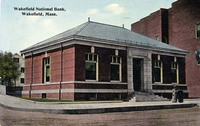 Wakefield National Bank, Wakefield, Mass.
Wakefield National Bank, Wakefield, Mass. Postcard shows the Wakefield National Bank building, at the corner of Main and Chestnut Streets. The location is now occupied by the Wakefield Savings Bank.
-
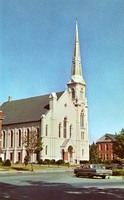 First Baptist Church, Main Street, Wakefield, Mass.
First Baptist Church, Main Street, Wakefield, Mass. Postcard shows the First Baptist Church on Main Street. The Church is the third building on the site, and was dedicated on December 11, 1872.
-
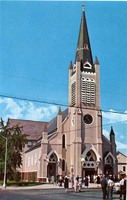 St. Joseph's Roman Catholic Church, Albion Street, Wakefield, Mass.
St. Joseph's Roman Catholic Church, Albion Street, Wakefield, Mass. Postcard shows St. Joseph's Church at the corner of Albion and Tuttle Streets. The building was destroyed by fire on March 24, 1977.
-
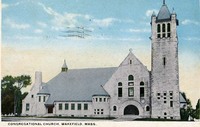 Congregational Church, Wakefield, Mass.
Congregational Church, Wakefield, Mass. Postcard shows the Congregational Church on the west side of Wakefield Common. The granite church is the fifth church on the site, and was dedicated on February 1, 1912.
-
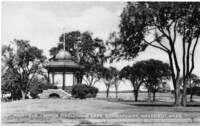 Wakefield Common overlooking Lake Quannpowitt, Wakefield, Mass.
Wakefield Common overlooking Lake Quannpowitt, Wakefield, Mass. Postcard shows Wakefield Common and the bandstand looking north from Church Street toward Lake Quannapowitt.
-
 Lucius Beebe Memorial Library, Wakefield, Mass.
Lucius Beebe Memorial Library, Wakefield, Mass. Postcard shows the Lucius Beebe Memorial Library after opening in 1923.
-
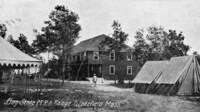 Bay State M.R.A. Range, Wakefield, Mass.
Bay State M.R.A. Range, Wakefield, Mass. Postcard shows Camp Plunkett, home of the Bay State Rifle Association. The Camp was purchased from them in 1926 by the Commonwealth of Massachusetts, and the name changed to Camp Curtis Guild. It is now home to the Massachusetts National Guard.
-
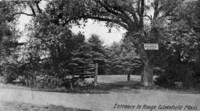 Entrance to range, Wakefield, Mass.
Entrance to range, Wakefield, Mass. Postcard shows the entrance to Camp Plunkett, home of the Bay State Rifle Association. The Camp was purchased from them in 1926 by the Commonwealth of Massachusetts, and the name changed to Camp Curtis Guild. It is now home to the Massachusetts National Guard.
-
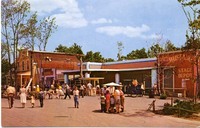 Gold Pan Gulch at Pleasure Island
Gold Pan Gulch at Pleasure Island "A rustic section at Pleasure Island traces the western movement of early New Englanders. Gun fights are frequent. Stage coaches, covered wagons, buckboards, surreys and a live steam railroad carry visitors into the romantic West. Diamond Lil's Saloon (soft drinks only), the Chisholm Trail, a gold mining operation for guests, and even a newspaper office are popular attractions. The multi-million dollar Park is in Wakefield, Mass., outside Boston, on Route 128, Exit 21A." -- Text from back of postcard.
-
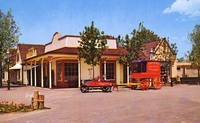 Authentic country store at Pleasure Island
Authentic country store at Pleasure Island "Breck's old country store charms thousands of visitors yearly-with its incredible collection of merchandise from an age long lost. Even a cracker barrel and checker board are available to youngsters. Unusual new gift and souvenir items are sold in the shop on the corner. The big Park covers 100 acres in Wakefield, Mass., on Route 128, Exit 21A, just outside Boston" -- Text from back of postcard.
-
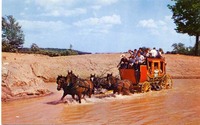 Fording the stream at Pleasure Island
Fording the stream at Pleasure Island "The Goldpan Gulch Stage Coach line in Pleasure Island, big new family recreation center in Wakefield, Mass., takes guests thru typical western badlands and splashes through broad streams, on the run for the Stage Depot. The authentic old-time stage coaches accommodate up to 20 children and adults." -- Text from back of postcard.
-
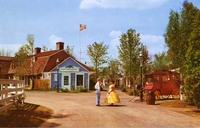 Colonial settlers at Pleasure Island
Colonial settlers at Pleasure Island "A boy and girl of colonial days stand along Clipper cove, the main street in charming Pleasure Island, the $4,000,000 family fun center in Wakefield, Mass., on Route 128, Exit 21A. The street is an authentic waterfront village as it might have looked a hundred years ago. Note the handspun chocolate shop and historic popcorn wagon." -- Text from back of postcard.
-
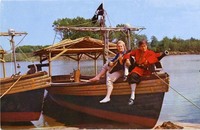 Exciting pirate ride at Pleasure Island
Exciting pirate ride at Pleasure Island "Pirates in costume welcome visitors in the authentic thatched-topped boats that sail regularly for Pirate's Cove at Pleasure Island in Wakefield, Mass., on Route 128, Exit 21A, just outside Boston. The popular vessels carry landlubbers to a realistic pirate's hideaway - complete with tree house, animals, lookout towers, and wrecked ships." -- Text from back of postcard.
-
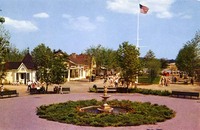 Entrance to fun at Pleasure Island
Entrance to fun at Pleasure Island "View from the front gate of Pleasure Island, in Wakefield, Mass., shows the Plaza in which thousands of talented free entertainers appear annually. Beyond the Plaza is the main street of Clipper Cove, a quaint attraction in the multi-million dollar family recreation center, on Route 128, Exit 21A." -- Text from back of postcard.
-
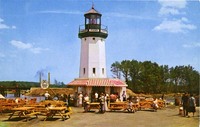 Hawkes Point light house at Pleasure Island
Hawkes Point light house at Pleasure Island "Dramatic memories of the men who went down to the sea in ships are recalled by the light house in Clipper Cove, at Pleasure Island, in Wakefield, Mass. The seaman's guide is a focal point in the authentic multi-million dollar reproduction of an early New England waterfront village. The Park is spread across almost a hundred acres on Route 128, Exit 21A, just outside Boston." -- Text from back of postcard.
-
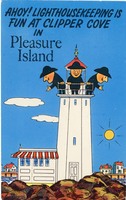 Clipper Cove light house
Clipper Cove light house "Ahoy! Light housekeeping is fun at Clipper Cove in Pleasure Island" -- from front of postcard
-
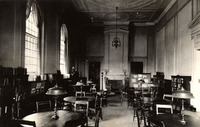 Lucius Beebe Memorial Library, Wakefield, Mass., Children's Room
Lucius Beebe Memorial Library, Wakefield, Mass., Children's Room Postcard shows the children's room, or south reading room, of the Lucius Beebe Memorial Library after opening in 1923.
-
 House at 142 Main Street, Wakefield, Mass.
House at 142 Main Street, Wakefield, Mass. Photos show the house located at 142 Main Street in Beebe Cove on the eastern shore of Lake Quannapowitt. Built in 1810 by noted architect Samuel McIntire of Salem, the Federal style house has several later alterations, including a cupola added between 1858 and 1865. The house was originally the home of the family of Lucius Beebe, and was known as the Beebe Estate or Beebe Farm. It was said to have had one of New England's first indoor bathrooms, with a bathtub "of monstrous proportions". The site was also once the location of the Derby-Beebe Summer House, a small elegant outbuilding also designed by Samuel McIntire. The summerhouse was later moved to Salem, Massachusetts, and is now owned by the Peabody Essex Museum.
-
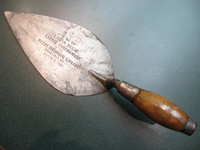 Trowel from the cornerstone-laying ceremony of the Lucius Beebe Memorial Library, Wakefield, Mass.
Trowel from the cornerstone-laying ceremony of the Lucius Beebe Memorial Library, Wakefield, Mass. Photos show views of the trowel used at the cornerstone-laying ceremony of the Lucius Beebe Memorial Library on March 17, 1922. The artifact was presented by Damien Hurlburt to Library Director Sharon Gilley in July 2009. The trowel was used by Lucia Beebe at the 1922 cornerstone-laying ceremony inaugurating the construction of the new library building, funded in large part by a donation from Junius Beebe, son of Lucius Beebe. Hurlburt found the trowel while cleaning out the basement of his home at 26 Daniel Road. The inscription on the trowel reads, 'USED BY LUCIA BEEBE LAYING CORNERSTONE OF LUCIUS BEEBE MEMORIAL LIBRARY WAKEFIELD MASS. MARCH 17, 1922'. Lucia Beebe was the niece of Lucius Beebe (for whom the library is named) and the sister of Lucius Morris Beebe, who was famous for his high style, society journalism and interest in railroading.
-
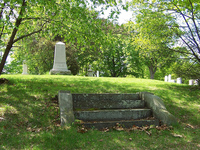 Yale family plot, Lakeside Cemetery, Wakefield, Mass.
Yale family plot, Lakeside Cemetery, Wakefield, Mass. Photos show views of the Yale family plot in Lakeside Cemetery on North Avenue. The plot is located east of White Ash Avenue between Spruce Avenue and Magnolia Path in the northeast corner of the cemetery.
-
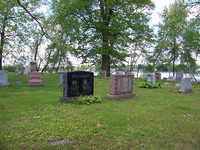 Grave of William R. and Gertude M. Spaulding, Lakeside Cemetery, Wakefield, Mass.
Grave of William R. and Gertude M. Spaulding, Lakeside Cemetery, Wakefield, Mass. Photos show views of the Spaulding gravestone in Lakeside Cemetery on North Avenue. The plot is located on the southern side of the point at the extreme eastern end of the cemetery.
-
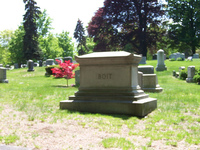 Grave of Elizabeth Boit, Lakeside Cemetery, Wakefield, Mass.
Grave of Elizabeth Boit, Lakeside Cemetery, Wakefield, Mass. Photos show views of the gravestone of Elizabeth Boit in Lakeside Cemetery on North Avenue. The plot is located near "Rainbow Path" at the northern end of the cemetery.
-
 Bayrd family plot, Lakeside Cemetery, Wakefield, Mass.
Bayrd family plot, Lakeside Cemetery, Wakefield, Mass. Photos show views of the Bayrd family plot in Lakeside Cemetery on North Avenue. The plot is located at the corner of Chestnut Avenue and Catalpa Avenue near the center of the cemetery.
-
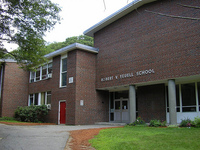 The Robert V. Yeuell School at 0 Crystal Street, Wakefield, Mass.
The Robert V. Yeuell School at 0 Crystal Street, Wakefield, Mass. Photos show the Robert V. Yeuell School at 0 Crystal Street on the east side of the street in the Greenwood section of Wakefield. The brick elementary school was built in the 1960s in response to overcrowding at the Greenwood School as a result of the Baby Boom. The school was named for Captain Robert V. Yeuell of the 224th Field Artillery Battalion, a Wakefield native who was killed in World War II. No longer used as a public school, in 2008 the Yeuell School is home to the SEEM Collaborative, a nonprofit organization that provides educational services to students with severe disabilities.
-
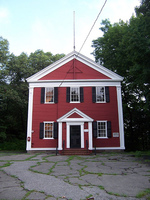 West Ward School at 39 Prospect Street, Wakefield, Mass.
West Ward School at 39 Prospect Street, Wakefield, Mass. Photos show views of the West Ward School located at 39 Prospect Street on the north side of the street between Goodwin and Nichols Streets. The school was built in 1847 and is thought to be the oldest two-room schoolhouse in Massachusetts that was in continuous use during its 147 years of operation. The school was eventually forced to close when the roof collapsed in 1994 and was turned over from the School Department to the Board of Selectmen. In 1998 the West Ward School Association was awarded permission to restore the building to its original use as a 19th century schoolhouse. The organization aims to make the building a "living history schoolhouse," giving children the opportunity to experience a classroom from the mid to late 19th century.
-
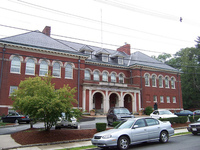 H. M. Warren School at 30 Converse Street, Wakefield, Mass.
H. M. Warren School at 30 Converse Street, Wakefield, Mass. Photos show views of the H. M. Warren School located at 30 Converse Street on the south side of the street at the corner of Jordan Avenue. The Renaissance Revival style brick structure was built around 1896 and named after Major Horace M. Warren, a local Civil War soldier. The school was closed in 1981, and later used in the 1990s by the local cable television station. The building was then renovated for use as the town's senior center, and opened on June 23, 2002.
-
 Wakefield Park stone entrance gate, Wakefield, Mass.
Wakefield Park stone entrance gate, Wakefield, Mass. Photos show the stone gates located at the intersection of Chestnut Street and Park Avenue at the entrance to the Wakefield Park neighborhood, the development of which began in 1886. The area was promoted as having a healthful and beautiful environment, with elegant homes and building restrictions.
-
 Wakefield Upper Depot at 27-29 Tuttle Street, Wakefield, Mass.
Wakefield Upper Depot at 27-29 Tuttle Street, Wakefield, Mass. Photos show views of the Wakefield Upper Depot train station located at 27-29 Tuttle Street on the east side of the street. The railroad tracks and North Avenue lie to the east of the building. The Victorian station is made of brick and was built in 1889. After being brick red for many years, it was repainted in historic colors in the early 2000s. The building's decorative chimney pots are particularly noteworthy. The Haverhill Line commuter rail to Boston still stops here at Wakefield Station, but the building itself is used for commerical offices.
-
 Upper Common, Wakefield, Mass.
Upper Common, Wakefield, Mass. Photos show views of the Upper Common in Wakefield. The Common is divided into two sections by Church Street, which runs east-west. The triangular portion south of Church Street, and bounded by Main and Common Streets, is known as the Upper Common, perhaps because of its slightly higher elevation than that of the Lower Common. It is approximately 2. 5 acres in area. It is more formal than the Lower Common, and has paved paths, flowering trees, benches, Victorian style lampposts, granite and iron fences, and several war memorials, most notably the Soldiers and Sailors Memorial for the Civil War.
-
 Unitarian Universalist Church at 326 Main Street, Wakefield, Mass.
Unitarian Universalist Church at 326 Main Street, Wakefield, Mass. Photos show views of the Unitarian Universalist Church located at 326 Main Street on the east side of the street opposite the Post Office. The church was originally built in 1839 in the Greek Revival style as a temple with a portico on columns facing Main Street. In 1859 the building was substantially altered: it was raised one story, the portico was removed, and a steeple was added. The new version of the building is Italianate in style and has wooden clapboards which on the lower floor are intended to resemble stone. The main entrance on the west end is obscured by a large linden tree in the middle of the front walkway, from which the church's Linden Tree Coffeehouse takes its name. The spire of the church was removed for safety and structural reasons on Tuesday, October 7, 2008.
-
 Wakefield Town Hall at 1 Lafayette Street, Wakefield, Mass.
Wakefield Town Hall at 1 Lafayette Street, Wakefield, Mass. Photos show views of Wakefield's Town Hall, housing the town's municipal offices, located at 1 Lafayette Street on the west side of the Upper Common at the corner of Common Street. Built around 1871, the brick Mansard/Italianate style building has been substantially altered from its original state. The structure was originally built as a high school, and had a clapboard exterior, with a mansard roof, tower, and elaborate exterior decoration. It was designed by architect John Stevens, who also designed the 1868 Town Hall and the Cyrus Wakefield Estate, both since demolished. He also designed the home at 21 Chestnut Street, which is still extant. The 1871 building was used as a high school until 1923. It was converted to town offices in 1938, and the building was considerably altered at this time: the tower was removed, the mansard roof was replaced with a gable, and much of the exterior ornament was removed. The main entrance, previously on Common Street, was shifted to Lafayette Street. Less extensive renovations, including handicapped accessibility, were completed around the turn of the 21st century.
-
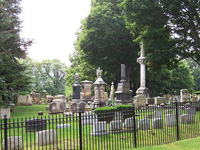 Temple Israel Cemetery, Wakefield, Mass.
Temple Israel Cemetery, Wakefield, Mass. Photos show views of the Jewish cemetery located on the western shore of Lake Quannpowitt, just south of Lakeside cemetery between Beacon Street and Lakeside Avenue. The cemetery was established in 1859 by Boston's Temple Israel, the first synagogue in Boston. The earliest of the more than 600 stones date from the 1860s. ;
-
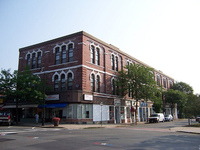 The Taylor/Wakefield Block at 414-416 Main Street, Wakefield, Mass.
The Taylor/Wakefield Block at 414-416 Main Street, Wakefield, Mass. Photos show views of the commercial building located at 414-416 Main Street on the east side of the street. The building runs along much of Lincoln Street. Built around 1870, the brick structure is Second Empire/Mansard Style, and the upper story windows have elaborate granite moldings in the Eastlake Style. The original high Mansard roof was removed in the mid 20th century. The block was the initial home of several important local businesses, including the Wakefield Item, and the Harvard Knitting Mills, before they moved elsewhere.
-
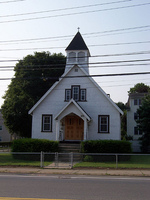 Saint Parascheva Romanian Orthodox Church at 171 Water Street, Wakefield, Mass.
Saint Parascheva Romanian Orthodox Church at 171 Water Street, Wakefield, Mass. Photos show views of the Saint Parascheva Romanian Orthodox Church located at 171 Water Street on the south side of the street at the corner of Melvin Street. Built around 1915, the vernacular Shingle Style chapel was originally built as a mission by Italian Americans on land donated to them by the Heywood-Wakefield Company across the street. Over the years the building has been used by several religious denominations, including the Christ Community Baptist Church, the Saint Sava Serbian Church, the Hope Alliance Church, and currently the Saint Parascheva Romanian Orthodox Church.
-
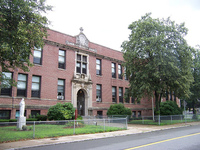 St. Joseph's School at 15 Gould Street, Wakefield, Mass.
St. Joseph's School at 15 Gould Street, Wakefield, Mass. Photos show views of the St. Joseph's School building located at 15 Gould Street on the north side of the street at the corner of Emerson Street. The Neo-Gothic style brick structure was built in 1924 by the Boston architectural firm Maginnis & Walsh. It has been used continuously as a parochial school affiliated with the parish of St. Joseph's Catholic Church.
-
 Solon O. Richardson II tomb, Lakeside Cemetery, Wakefield, Mass.
Solon O. Richardson II tomb, Lakeside Cemetery, Wakefield, Mass. Photos show views of the tomb of Solon O. Richardson II and his wife Abbie in Lakeside Cemetery on North Avenue. The plot with its red granite obelisk is located on the north side of "Beech Avenue", between "Maple Avenue" and "Oak Avenue" toward the south end of the cemetery. Richardson was the son of Dr. Solon O. Richardson, Sr. , who funded the local militia company, the Richardson Light Guard.
-
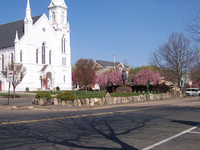 Hiker Monument and Rockery, Wakefield, Mass.
Hiker Monument and Rockery, Wakefield, Mass. Photos show views of the Rockery in the middle of Main Street at the intersection of Crescent Street. The Rockery was contructed to beautify the area in the 1880s, and at the time was often called the "Grotto". The structure was completed in 1884 at a cost of about $2,600, and included a fountain which splashed water over the vine-covered rocks into the pool below. The bronze Hiker Monument, by sculptor Theo Alice Ruggles Kitson, is sometimes mistaken for a Revolutionary War minuteman, but was actually erected in honor of those Wakefield citizens who fought in the Spanish-American War. The statue was dedicated on October 12, 1926. The Rockery is also the location of Wakefield's town Christmas tree, which is placed in front of the Hiker statue during the holiday season.
-
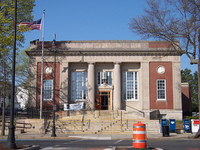 Wakefield Post Office at 321 Main Street, Wakefield, Mass.
Wakefield Post Office at 321 Main Street, Wakefield, Mass. Photos show the U. S. Post Office located at 321 Main Street on the west side of the street at the corner of Yale Avenue. Wakefield's post office was located in several places in town before this building was built, the latest home having been in the building at 9 Albion Street, now the Wakefield Municipal Gas & Light Department, where it was housed from 1924 to 1937. Built in 1936, the new neo-renaissance style structure was designed by architect Louis A. Simon. It has an exterior of red brick and cast stone, and on the Main Street facade are medallions of Benjamin Franklin and George Washington. A large rear addition was added in 1970.
-
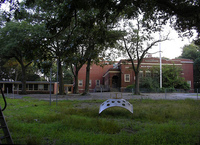 The Montrose School at 531 Lowell Street, Wakefield, Mass.
The Montrose School at 531 Lowell Street, Wakefield, Mass. Photos show the Montrose School at 531 Lowell Street on the south side of the street opposite Coolidge Park in the Montrose section of Wakefield. The brick school was built in in 1918 to serve elementary school students in the northeast section of Wakefield, known as Montrose. The school was enlarged and remodeled in 1930. By the 1990s, the school was no longer being used for educational purposes, and students in that part of town attended classes at the newly modernized Dolbeare School, less than a mile away near the corner of Lowell and Vernon streets. The Montrose was briefly leased as temporary studio space by Wakefield Community Access Television (WCAT) while a permanent studio was being built. In 2001, the School Department turned the Montrose School over to the Selectmen to determine its long-term future. The building subsequently served as temporary headquarters for the Wakefield Police and Fire Departments while the new Public Safety Building was being constructed downtown. In 2008, after several years of study, the building and grounds were sold to Symes Development, LLC. The building was razed in September 2008 and replaced by a subdevelopment of 10 or 11 single family homes.
-
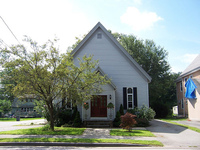 Montrose Chapel at 292-294 Salem Street, Wakefield, Mass.
Montrose Chapel at 292-294 Salem Street, Wakefield, Mass. Photos show views of the Montrose Chapel located at 292-294 Salem Street on the south side of the street at the corner of Drummer Lane. The Stick Style chapel was built in 1885-86 and dedicated on April 28, 1886. From 1946 to 1981, the building was used as the Montrose Branch of the Lucius Beebe Memorial Library. After it closed, the building was converted to private residences.
-
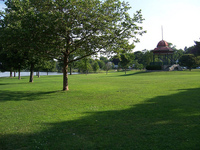 Lower Common, Wakefield, Mass.
Lower Common, Wakefield, Mass. Photos show views of the Lower Common in Wakefield. The Common is divided into two sections by Church Street, which runs east-west. The more or less rectangular portion north of Church Street, and bounded by Main Street and Lake Avenue, is known as the Lower Common, perhaps because of its slightly lower elevation as it slopes down to the lake. It is approximately 6. 75 acres in area. It is less formal than the Upper Common, and has few amenities or furnishings other than a wide sward of lawn, a number of widely spaced trees, and the Bandstand, which was built with funds from the Sweetser bequest in 1885.
-
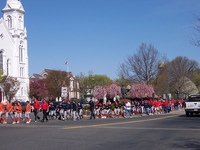 Little League parade, Wakefield, Mass. , April 26, 2008
Little League parade, Wakefield, Mass. , April 26, 2008 Photos show scenes of the 57th annual Wakefield Little League parade, which was held for baseball and softball players. The teams marched from Wakefield Common down Main Street, east on Water Street, and ended with ceremonies at Fernald Field on Del Carmine Street.
-
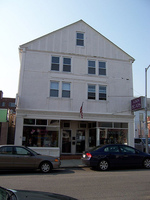 The Hibernian Building at 18 Albion Street, Wakefield, Mass.
The Hibernian Building at 18 Albion Street, Wakefield, Mass. Photos show views of the commercial building located at 18 Albion Street on the south side of the street at the corner of Foster Street. The structure was originally built around 1800 and located a few buildings to the east at the corner of Albion and Main Streets. Samuel Wiley had built the house, and later expanded it to include a tavern. In 1858 the building was raised and a first floor added underneath. It is at this time that it was known as the Quannapowitt House. In the 1780s the tavern was broken into pieces and moved. The southern end was moved to the current location at the corner of Albion and Foster Streets, and it was converted to a neo-Tudor style with ornamental half-timbering and a stucco exterior. Starting in 1924 it was used by the Hibernian Order. In more recent years it has also been known as the Sardella Building. The building now incorporates 6 Foster Street as well as the Albion Street address.
-
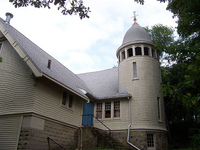 Greenwood Union Church at 4 Oak Street, Wakefield, Mass.
Greenwood Union Church at 4 Oak Street, Wakefield, Mass. Photos show views of the Greenwood Union Church located at 4 Oak Street on the north side of the street at the corner of Main Street. The Queen Anne/Shingle Style church was built in 1884 and remodeled in 1921. A large modern sanctuary was added to the west in 1956.
-
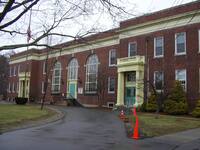 The Greenwood School at 1030 Main Street, Wakefield, Mass.
The Greenwood School at 1030 Main Street, Wakefield, Mass. Photos show views of the Greenwood Elementary School located at 1030 Main Street on the east side of the street opposite Melrose Terrace in the Greenwood section of Wakefield. The brick school was built in 1897 and enlarged and renovated in 1902 and 1924.
-
 Franklin School at 100 Nahant Street, Wakefield, Mass.
Franklin School at 100 Nahant Street, Wakefield, Mass. Photos show the Franklin School at 100 Nahant Street at the corner of Traverse Street. The Colonial Revival style brick school was built in 1902, and extensively remodeled in 1925, at which time its hip roof and a large columned portico was removed. A classroom wing was also added. The school was named for an 1871 grammar school which had been located nearby on Franklin Street. The Franklin school closed in 2004.
-
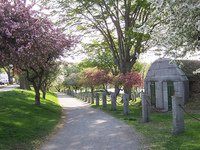 Floral Way, Wakefield, Mass.
Floral Way, Wakefield, Mass. Photos show views of the Floral Way, an arbored walkway roughly 800 feet long on the south shore of Lake Quannapowitt between the Old Burying Ground and the Hartshorne House. The Floral Way was planted in 1949, mostly with flowering crabtrees, as a living memorial to the town's servicemen and women of all wars.
-
 First Parish Congregational Church at 1 Church Street, Wakefield, Mass.
First Parish Congregational Church at 1 Church Street, Wakefield, Mass. Photos show the church located at the corner of Church Street and Lake Avenue on the west side of the Lower Common near the lake. Sometimes called the "big stone church", the Romanesque Revival style church is built of Massachusetts granite with a slate roof and was designed by the Boston architectural firm Hartwell, Richardson & Driver. This structure is the fifth for the church, and was built in 1912 from the ruins of the previous structure on the site, which was gutted by fire in 1909. Renovations and enlargements were done in 1952-1953, adding a chapel, offices, and classrooms.
-
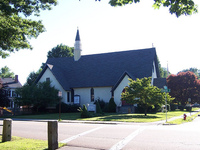 Emmanuel Episcopal Church at 5 Bryant Street, Wakefield, Mass.
Emmanuel Episcopal Church at 5 Bryant Street, Wakefield, Mass. Photos show views of the Emmanuel Episcopal Church located at 5 Bryant Street on the east side of the Upper Common at the corner of Main and Bryant Streets. Built around 1881, the stick style building was originally located on Water Street. It was enlarged in 1891, and in 1900 was moved to its present location, its original clapboarding covered with stucco. In 1903, the Tudor Revival style rectory was built and connected to the church by an arcade of paired columns. The rectory has a shingle exterior and diamond-paned windows. The Canterbury Children's Center is run out of the church, and maintains an enclosed playground on the north side of the property.
-
 The John Charles Doyle Elementary School at 11 Paul Avenue, Wakefield, Mass.
The John Charles Doyle Elementary School at 11 Paul Avenue, Wakefield, Mass. Photos show views of the John Charles Doyle Elementary School located at 11 Paul Avenue on the west side of town near the Stoneham town line. The brick school was built to relieve overcrowding on the West Side resulting from the Baby Boom. On March 13, 1958 Town Meeting voted to authorize the Board of Selectmen to purchase or take the land by right of eminent domain for school purposes. The school opened to students in September 1961. No longer used as a public elementary school, in 2008 the Doyle is home to the independent, nonprofit Odyssey Day School, which leases the building from the Town of Wakefield.
-
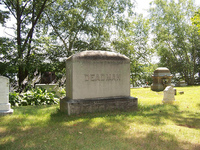 Deadman tomb, Lakeside Cemetery, Wakefield, Mass.
Deadman tomb, Lakeside Cemetery, Wakefield, Mass. Photos show views of the Deadman tomb in Lakeside Cemetery on North Avenue. The tomb is located on "Oak Avenue" opposite "Beech Avenue" near the lakeshore at the southeast corner of the cemetery.
-
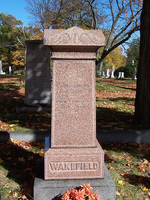 Cyrus Wakefield tomb, Lakeside Cemetery, Wakefield, Mass.
Cyrus Wakefield tomb, Lakeside Cemetery, Wakefield, Mass. Photos show views of the tomb of Cyrus Wakefield and his wife Eliza in Lakeside Cemetery on North Avenue. The plot with its red granite tomb is located at plot #109 on the east side of "Maple Avenue", between "Beech Avenue" and "Walnut Avenue" toward the south end of the cemetery. Cyrus Wakefield is probably the town's best known citizen and philanthropist, and was the owner of the Wakefield Rattan Company, one of the town's main industries in the 19th century. The town changed its name from South Reading to Wakefield in 1868 in his honor.
-
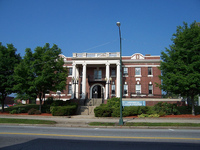 Americal Civic Center at 467 Main Street, Wakefield, Mass.
Americal Civic Center at 467 Main Street, Wakefield, Mass. Photos show the former Massachusetts state armory building located at 467 Main Street on the west side of the street at the corner of Armory Street. The neoclassical building was dedicated on January 15, 1913. In 1975 the town of Wakefield purchased the armory from the state for one dollar. It is now known as the Americal Civic Center and operated by the Americal Civic Center Association.
-
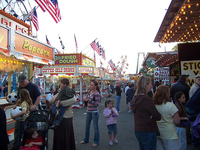 Traveling carnival, Wakefield, Mass. , April, 2008
Traveling carnival, Wakefield, Mass. , April, 2008 Photos show scenes of the traveling carnival which comes annually to Wakefield. In 2008, Fanelli's Traveling Theme Park took place on Main Street in the Galvin Middle School parking lot next to the Americal Civic Center from Tuesday through Saturday of April school vacation week. The carnival offered several traditional thrill rides, some for young children, including a Ferris wheel, slide, and merry-go-round. A traditional midway offered popcorn, candied apples, fried dough, and hot dogs, as well as games of chance where players could win toys and prizes.
-
 Mun Su Sa Buddhist temple at 231 Salem Street, Wakefield, Mass.
Mun Su Sa Buddhist temple at 231 Salem Street, Wakefield, Mass. Photos show views of the Mun Su Sa Buddhist temple located at 231 Salem Street on the north side of the street at the intersection with New Salem Street.
-
 The Kingman/Bourdon Block at 369 Main Street, Wakefield, Mass.
The Kingman/Bourdon Block at 369 Main Street, Wakefield, Mass. Photos show views of the commercial building located at 369 Main Street on the west side of the street at the corner of Albion Street. Built around 1860 by Davis & Bryant, Builders for Samuel Kingman, the Italianate Style building is now covered with vinyl siding. Most of the original exterior decoration has been removed, although the structure's original massing can still be discerned. Kingman was a tailor, and later postmaster for the town. The building housed both his tailor shop and, for a time, the Post Office. In later years the Richardson Light Guard held meetings on the third floor. More recently, the building has been known as the Bourdon Block after the Bourdon Photography Studio which was on the ground floor.
-
 Boit Home at 5 Bennett Street, Wakefield, Mass.
Boit Home at 5 Bennett Street, Wakefield, Mass. Photos show the Elizabeth Boit Home for Aged Women located between Bennett Street and Richardson Street near Main Street. The Italianate style home was built between 1875 and 1881, possibly for Marcus Simpson, who worked for the Wakefield Rattan Company. It was purchased in 1894 to be used as a home for elderly women. In 1921 the name was changed to honor Elizabeth Boit, who had given generously to the institution.
-
 Beebe family plot, Lakeside Cemetery, Wakefield, Mass.
Beebe family plot, Lakeside Cemetery, Wakefield, Mass. Photos show views of one of the Beebe family plots in Lakeside Cemetery on North Avenue. The plot is located at the corner of "Rainbow Avenue" and "Lakeside Avenue" at the northern end of the cemetery.
-
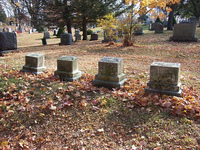 Beebe family plot, Lakeside Cemetery, Wakefield, Mass.
Beebe family plot, Lakeside Cemetery, Wakefield, Mass. Photos show views of one of the Beebe family plots in Lakeside Cemetery on North Avenue. The plot is located near the corner of "Rainbow Avenue" and "Lakeside Avenue" at the northern end of the cemetery.
-
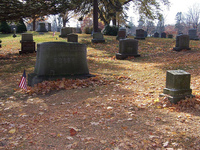 Beebe family plot, Lakeside Cemetery, Wakefield, Mass.
Beebe family plot, Lakeside Cemetery, Wakefield, Mass. Photos show views of one of the Beebe family plots in Lakeside Cemetery on North Avenue. The plot is located about 40 meters east of the corner of "Rainbow Avenue" and "Lakeside Avenue" at the northern end of the cemetery.
-
 Beebe family plot, Lakeside Cemetery, Wakefield, Mass.
Beebe family plot, Lakeside Cemetery, Wakefield, Mass. Photos show views of one of the Beebe family plots in Lakeside Cemetery on North Avenue. The plot is located about 50 meters east of the corner of "Rainbow Avenue" and "Lakeside Avenue" at the northern end of the cemetery.
-
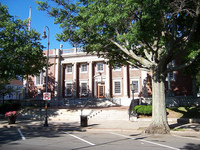 Lucius Beebe Memorial Library at 345 Main Street, Wakefield, Mass.
Lucius Beebe Memorial Library at 345 Main Street, Wakefield, Mass. Photos show views of the Lucius Beebe Memorial Library located at 345 Main Street on the west side of the street at the corner of Avon Street. Originally established in 1856, the library had several homes before settling at its present location. The current structure was built in several stages. The section on Main Street was built in 1922, and designed by Ralph Adams Cram of the Boston firm Cram & Ferguson. Cram was a medievalist best known for his many Gothic churches, and the classical revival style of this building was a stylistic departure from his usual work. The building has a large skylit entrance hall flanked by two reading rooms, each up a short flight of marble stairs. The north reading room is graced by fourteen medallions depicting famous literary figures. Both reading rooms include working marble fireplaces, built-in wooden bookshelves, and elegant Adam style plaster detailing on the walls and ceilings. The central lobby has a black and white marble floor and cast iron stair railings with urn motifs that echo the stone urns on the building's facade. The beehive, a symbol of the Beebe family, is used throughout the building as a decorative motif, and was chosen in 1998 as the Library's logo. In 1967 a modern addition was added to the rear of the building, greatly expanding the space. In 1997 the entire building was renovated within the existing footprint. A small cantilevered addition was added from the second story of the rear of the building, and the exterior entrance on Avon Street was completely rebuilt, with new windows and a brick facade matching the 1922 building.
 Lake Quannapowitt from Church Street, Wakefield, Mass. Postcard shows a view of Lake Quannapowitt from Church Street on the southern shore.
Lake Quannapowitt from Church Street, Wakefield, Mass. Postcard shows a view of Lake Quannapowitt from Church Street on the southern shore. Band stand, Wakefield, Mass. Postcard shows a view of the bandstand on the Common, built in 1885 at a cost of $2,500 as a replacement for an earlier wooden bandstand. The new bandstand was also known as the Pagoda and the Music Pavilion.
Band stand, Wakefield, Mass. Postcard shows a view of the bandstand on the Common, built in 1885 at a cost of $2,500 as a replacement for an earlier wooden bandstand. The new bandstand was also known as the Pagoda and the Music Pavilion. Main Street, lakeside, Wakefield, Mass. Postcard shows a view of the lakeside on the eastern shore of Lake Quannapowitt.
Main Street, lakeside, Wakefield, Mass. Postcard shows a view of the lakeside on the eastern shore of Lake Quannapowitt. Lake Quannapowitt, Wiley's boat house, Congregational and Baptist churches, Wakefield, Mass. Postcard shows a view from the eastern shore of Lake Quannapowitt toward the Common.
Lake Quannapowitt, Wiley's boat house, Congregational and Baptist churches, Wakefield, Mass. Postcard shows a view from the eastern shore of Lake Quannapowitt toward the Common. Town Hall, Wakefield, Mass.
Town Hall, Wakefield, Mass.  North End of Crystal Lake from Hart's Hill Tower, Wakefield, Mass. Postcard shows a view over Crystal Lake looking north from the top of Hart's Hill. Main Street is visible in the foreground. On the far shore the Crystal Lake water filtration plant can be seen. At the upper right the buildings of the Harvard Knitting Mills complex are visible.
North End of Crystal Lake from Hart's Hill Tower, Wakefield, Mass. Postcard shows a view over Crystal Lake looking north from the top of Hart's Hill. Main Street is visible in the foreground. On the far shore the Crystal Lake water filtration plant can be seen. At the upper right the buildings of the Harvard Knitting Mills complex are visible. The Rockery, Wakefield, Mass. Postcard shows the Rockery on Main Street, looking north toward the Common.
The Rockery, Wakefield, Mass. Postcard shows the Rockery on Main Street, looking north toward the Common. Baptist Church & Rockery, Wakefield, Mass. Postcard depicts a view northwest across Main Street towards the Baptist Church. The Rockery and High School (now Town Hall) are also visible.
Baptist Church & Rockery, Wakefield, Mass. Postcard depicts a view northwest across Main Street towards the Baptist Church. The Rockery and High School (now Town Hall) are also visible. Soldiers and sailors memorial, Wakefield, Mass. Postcard shows the Soldiers and Sailors Memorial on the lower common, erected in 1902 to commemorate Wakefield's Civil War casualties.
Soldiers and sailors memorial, Wakefield, Mass. Postcard shows the Soldiers and Sailors Memorial on the lower common, erected in 1902 to commemorate Wakefield's Civil War casualties. Lake Quannapowitt and park, Wakefield, Mass. Postcard shows Wiley's boat house on the shore of Lake Quannpowitt on Wakefield Common at the end of Spaulding Street.
Lake Quannapowitt and park, Wakefield, Mass. Postcard shows Wiley's boat house on the shore of Lake Quannpowitt on Wakefield Common at the end of Spaulding Street. Spanish war monument and Rockery, Wakefield, Mass. Postcard shows the Rockery on Main Street, looking north. The statue known as "The Hiker", by Theo Alice Ruggles Kitson, was dedicated on October 12, 1926 in honor of Wakefield citizens who took part in the Spanish-American War.
Spanish war monument and Rockery, Wakefield, Mass. Postcard shows the Rockery on Main Street, looking north. The statue known as "The Hiker", by Theo Alice Ruggles Kitson, was dedicated on October 12, 1926 in honor of Wakefield citizens who took part in the Spanish-American War. [Paul Revere bell] Postcard shows the large "Paul Revere bell", formerly on display at the Lucius Beebe Memorial Library. The bell is famous in town because it was made by the firm of Paul Revere. The work was probably done by his son, Joseph, but the bell is considered an original Revere bell because it was cast during his lifetime. The bell, weighing "about eight hundred and fifty weight", was purchased in 1815 by the town of South Reading for the parish for $350. The bell was hung in steeple of the First Parish Congregational Meeting House. In 1859 it was moved to the cupola of the Town's meeting hall on Church Street. The town hall was moved in 1871 to the corner of Main and Salem Streets and the bell moved with it. In 1888 is was moved to the new High School, what is now the William Lee Memorial Town Hall (Lafayette Building). In 1930 the bell was relocated to the lower lobby of Beebe Library, and in 1973 was brought up to the main floor lobby in the historic part of the building. The bell was transferred to the Wakefield Savings Bank during the Library's renovation and reconstruction in 1997. Later, it was moved to the lobby of the Galvin Middle School, where it remains today.
[Paul Revere bell] Postcard shows the large "Paul Revere bell", formerly on display at the Lucius Beebe Memorial Library. The bell is famous in town because it was made by the firm of Paul Revere. The work was probably done by his son, Joseph, but the bell is considered an original Revere bell because it was cast during his lifetime. The bell, weighing "about eight hundred and fifty weight", was purchased in 1815 by the town of South Reading for the parish for $350. The bell was hung in steeple of the First Parish Congregational Meeting House. In 1859 it was moved to the cupola of the Town's meeting hall on Church Street. The town hall was moved in 1871 to the corner of Main and Salem Streets and the bell moved with it. In 1888 is was moved to the new High School, what is now the William Lee Memorial Town Hall (Lafayette Building). In 1930 the bell was relocated to the lower lobby of Beebe Library, and in 1973 was brought up to the main floor lobby in the historic part of the building. The bell was transferred to the Wakefield Savings Bank during the Library's renovation and reconstruction in 1997. Later, it was moved to the lobby of the Galvin Middle School, where it remains today. Rosson's Grove, Wakefield, Mass. Postcard shows Rosson's Grove, located at the northern end of Lake Quannapowitt.
Rosson's Grove, Wakefield, Mass. Postcard shows Rosson's Grove, located at the northern end of Lake Quannapowitt. Interior view of St. Joseph's church, Wakefield, Mass. Postcard shows the interior of St. Joseph's Church at the corner of Albion and Tuttle Streets. The building was destroyed by fire on March 24, 1977.
Interior view of St. Joseph's church, Wakefield, Mass. Postcard shows the interior of St. Joseph's Church at the corner of Albion and Tuttle Streets. The building was destroyed by fire on March 24, 1977. Harvard Knitting Mill, Wakefield, Mass. Postcard depicts the Harvard Knitting Mill complex looking south from the corner of Albion and Foundry Streets.
Harvard Knitting Mill, Wakefield, Mass. Postcard depicts the Harvard Knitting Mill complex looking south from the corner of Albion and Foundry Streets. Crystal Lake and Wakefield from Hart's Hill, Wakefield, Mass. Postcard shows a view of Crystal Lake and Wakefield looking northwest from the top of Hart's Hill.
Crystal Lake and Wakefield from Hart's Hill, Wakefield, Mass. Postcard shows a view of Crystal Lake and Wakefield looking northwest from the top of Hart's Hill. State armory, Wakefield, Massachusetts Postcard shows the Massachusetts State Armory on Main Street at the corner of Armory Street. The building was dedicated on January 15, 1913. In 1975 the town of Wakefield purchased the armory from the state for one dollar. It is now known as the Americal Civic Center and operated by the Americal Civic Center Association.
State armory, Wakefield, Massachusetts Postcard shows the Massachusetts State Armory on Main Street at the corner of Armory Street. The building was dedicated on January 15, 1913. In 1975 the town of Wakefield purchased the armory from the state for one dollar. It is now known as the Americal Civic Center and operated by the Americal Civic Center Association. High School, Wakefield, Massachusetts Postcard shows a view of Wakefield High School on Main Street at the location of the current Galvin Middle School parking lot. The building was opened in 1923 and was later known as the Atwell building in honor of Superintendent of Schools Willard B. Atwell. It was destroyed by fire on December 12, 1971.
High School, Wakefield, Massachusetts Postcard shows a view of Wakefield High School on Main Street at the location of the current Galvin Middle School parking lot. The building was opened in 1923 and was later known as the Atwell building in honor of Superintendent of Schools Willard B. Atwell. It was destroyed by fire on December 12, 1971. Lake Quannapowitt, Wakefield, Mass. Postcard shows a view of pleasure boats on Lake Quannapowitt, looking north up Main Street from the Common.
Lake Quannapowitt, Wakefield, Mass. Postcard shows a view of pleasure boats on Lake Quannapowitt, looking north up Main Street from the Common. Floral Way, Lake Quannapowitt, Wakefield, Mass. Postcard shows a view of the Floral Way, an arbored walkway roughly 800 feet long on the south shore of Lake Quannapowitt between the Old Burying Ground and the Hartshorne House. The Floral Way was planted in 1949, mostly with flowering crabtrees, as a living memorial to the town's servicemen and women of all wars.
Floral Way, Lake Quannapowitt, Wakefield, Mass. Postcard shows a view of the Floral Way, an arbored walkway roughly 800 feet long on the south shore of Lake Quannapowitt between the Old Burying Ground and the Hartshorne House. The Floral Way was planted in 1949, mostly with flowering crabtrees, as a living memorial to the town's servicemen and women of all wars. Harvard Knitting Mill, Wakefield, Mass. Postcard depicts the Harvard Knitting Mill complex looking south from the corner of Albion and Foundry Streets.
Harvard Knitting Mill, Wakefield, Mass. Postcard depicts the Harvard Knitting Mill complex looking south from the corner of Albion and Foundry Streets. Lucius Beebe Memorial Library, Wakefield, Mass. Postcard shows the Lucius Beebe Memorial Library after opening in 1923.
Lucius Beebe Memorial Library, Wakefield, Mass. Postcard shows the Lucius Beebe Memorial Library after opening in 1923. Wakefield Square, Wakefield, Mass. Postcard shows the west side of Wakefield Square looking north up Main Street from Richardson Avenue to the Baptist Church. Electric streetcars, which were discontinued in the early 1930s, are visible.
Wakefield Square, Wakefield, Mass. Postcard shows the west side of Wakefield Square looking north up Main Street from Richardson Avenue to the Baptist Church. Electric streetcars, which were discontinued in the early 1930s, are visible. Armory, Wakefield, Mass. Postcard shows the Massachusetts State Armory on Main Street at the corner of Armory Street. The building was dedicated on January 15, 1913. In 1975 the town of Wakefield purchased the armory from the state for one dollar. It is now known as the Americal Civic Center and operated by the Americal Civic Center Association.
Armory, Wakefield, Mass. Postcard shows the Massachusetts State Armory on Main Street at the corner of Armory Street. The building was dedicated on January 15, 1913. In 1975 the town of Wakefield purchased the armory from the state for one dollar. It is now known as the Americal Civic Center and operated by the Americal Civic Center Association. Lake Quannapowitt and lakeside, Wakefield, Mass. Postcard shows a view of Lake Quannapowitt, and the upper common, including the bandstand, looking north from the corner of Main and Pearl Streets.
Lake Quannapowitt and lakeside, Wakefield, Mass. Postcard shows a view of Lake Quannapowitt, and the upper common, including the bandstand, looking north from the corner of Main and Pearl Streets. Great train robbery at Pleasure Island "On every trip of the Pleasure Island and Western Railroad, attempts are made by armed bandits to board the train to rob passengers and the conductor. They never succeed because the trusty sheriff riding on the train guns them down. (At Pleasure Island, Wakefield, Mass., on Route 128, Exit 21-A, just 14 miles North of Boston" -- Text from back of postcard.
Great train robbery at Pleasure Island "On every trip of the Pleasure Island and Western Railroad, attempts are made by armed bandits to board the train to rob passengers and the conductor. They never succeed because the trusty sheriff riding on the train guns them down. (At Pleasure Island, Wakefield, Mass., on Route 128, Exit 21-A, just 14 miles North of Boston" -- Text from back of postcard. Looking toward 1000 yard range B.S.M.R.A., Wakefield, Mass. Postcard shows 1000 yard rifle range at Camp Plunkett, home of the Bay State Rifle Association. The Camp was purchased from them in 1926 by the Commonwealth of Massachusetts, and the name changed to Camp Curtis Guild. It is now home to the Massachusetts National Guard.
Looking toward 1000 yard range B.S.M.R.A., Wakefield, Mass. Postcard shows 1000 yard rifle range at Camp Plunkett, home of the Bay State Rifle Association. The Camp was purchased from them in 1926 by the Commonwealth of Massachusetts, and the name changed to Camp Curtis Guild. It is now home to the Massachusetts National Guard. Camp Curtis Guild Postcard shows rifle practice at Camp Curtis Guild, formerly Camp Plunkett. The Camp was purchased from the Bay State Rifle Association in 1926 by the Commonwealth of Massachusetts. It is now home to the Massachusetts National Guard.
Camp Curtis Guild Postcard shows rifle practice at Camp Curtis Guild, formerly Camp Plunkett. The Camp was purchased from the Bay State Rifle Association in 1926 by the Commonwealth of Massachusetts. It is now home to the Massachusetts National Guard. Company Street Camp Plunkett, Wakefield, Mass. Postcard shows rifle practice at Camp Curtis Guild, formerly Camp Plunkett. The Camp was purchased from the Bay State Rifle Association in 1926 by the Commonwealth of Massachusetts. It is now home to the Massachusetts National Guard.
Company Street Camp Plunkett, Wakefield, Mass. Postcard shows rifle practice at Camp Curtis Guild, formerly Camp Plunkett. The Camp was purchased from the Bay State Rifle Association in 1926 by the Commonwealth of Massachusetts. It is now home to the Massachusetts National Guard. Camp Curtis Guild Postcard shows rifle practice at Camp Curtis Guild, formerly Camp Plunkett. The Camp was purchased from the Bay State Rifle Association in 1926 by the Commonwealth of Massachusetts. It is now home to the Massachusetts National Guard.
Camp Curtis Guild Postcard shows rifle practice at Camp Curtis Guild, formerly Camp Plunkett. The Camp was purchased from the Bay State Rifle Association in 1926 by the Commonwealth of Massachusetts. It is now home to the Massachusetts National Guard. Camp Curtis Guild Postcard shows rifle practice at Camp Curtis Guild, formerly Camp Plunkett. The Camp was purchased from the Bay State Rifle Association in 1926 by the Commonwealth of Massachusetts. It is now home to the Massachusetts National Guard.
Camp Curtis Guild Postcard shows rifle practice at Camp Curtis Guild, formerly Camp Plunkett. The Camp was purchased from the Bay State Rifle Association in 1926 by the Commonwealth of Massachusetts. It is now home to the Massachusetts National Guard. Camp Curtis Guild Postcard shows rifle practice at Camp Curtis Guild, formerly Camp Plunkett. The Camp was purchased from the Bay State Rifle Association in 1926 by the Commonwealth of Massachusetts. It is now home to the Massachusetts National Guard.
Camp Curtis Guild Postcard shows rifle practice at Camp Curtis Guild, formerly Camp Plunkett. The Camp was purchased from the Bay State Rifle Association in 1926 by the Commonwealth of Massachusetts. It is now home to the Massachusetts National Guard. Beebe Public Library Postcard shows the Lucius Beebe Memorial Library during construction. the new library opened in 1922.
Beebe Public Library Postcard shows the Lucius Beebe Memorial Library during construction. the new library opened in 1922. High School, Wakefield, Mass. Postcard shows the High School on Wakefield Common at Lafayette Street. Built in 1871, the building was used for school purposes until 1937, when it was remodeled as part of a WPA project for municipal offices. The building, also known as the Lafayette building, is now Wakefield's Town Hall.
High School, Wakefield, Mass. Postcard shows the High School on Wakefield Common at Lafayette Street. Built in 1871, the building was used for school purposes until 1937, when it was remodeled as part of a WPA project for municipal offices. The building, also known as the Lafayette building, is now Wakefield's Town Hall. Lincoln School, Wakefield, Mass. Postcard shows the Lincoln School at the corner of Crescent and Otis Streets. The school was built in 1892 and is now used for elderly housing.
Lincoln School, Wakefield, Mass. Postcard shows the Lincoln School at the corner of Crescent and Otis Streets. The school was built in 1892 and is now used for elderly housing. St. Florence's Roman Catholic Church, Butler Avenue, Wakefield, Mass. Postcard shows St. Florence's Church on Butler Avenue. The building was completed in 1960.
St. Florence's Roman Catholic Church, Butler Avenue, Wakefield, Mass. Postcard shows St. Florence's Church on Butler Avenue. The building was completed in 1960. Lord Wakefield Motor Hotel "Lord Wakefield Motor Hotel, At Exit 35, Route 128, Wakefield, Mass., Tel. 617-245-6100. Colonial decorated lakeview dining room, coffee shop, and new Cypress Cove cocktail lounge augment the 92 fully carpeted, air-conditioned bedrooms. Spacious parking and a crystal clear swimming pool add to your pleasure at this modern AAA recommended hostelry." - Text from back of postcard.
Lord Wakefield Motor Hotel "Lord Wakefield Motor Hotel, At Exit 35, Route 128, Wakefield, Mass., Tel. 617-245-6100. Colonial decorated lakeview dining room, coffee shop, and new Cypress Cove cocktail lounge augment the 92 fully carpeted, air-conditioned bedrooms. Spacious parking and a crystal clear swimming pool add to your pleasure at this modern AAA recommended hostelry." - Text from back of postcard. Colonial Hilton Inn "Colonial Hilton Inn, Exit 31 and 32, Rte. 128, Wakefield, Massachusetts, Tel.: 617-245-9300. New England's most spectacular motor inn featuring 180 luxurious rooms and suites. Year 'round glass enclosed pool, health club, 18 hole golf course, cocktail lounge, coffee shop, banquet and meeting rooms. Colonial's Famous Restaurant and Cocktail Lounges with dancing and entertainment. About 20 minutes to downtown Boston and airport." - text from back of postcard.
Colonial Hilton Inn "Colonial Hilton Inn, Exit 31 and 32, Rte. 128, Wakefield, Massachusetts, Tel.: 617-245-9300. New England's most spectacular motor inn featuring 180 luxurious rooms and suites. Year 'round glass enclosed pool, health club, 18 hole golf course, cocktail lounge, coffee shop, banquet and meeting rooms. Colonial's Famous Restaurant and Cocktail Lounges with dancing and entertainment. About 20 minutes to downtown Boston and airport." - text from back of postcard. Wakefield National Bank, Wakefield, Mass. Postcard shows the Wakefield National Bank building, at the corner of Main and Chestnut Streets. The location is now occupied by the Wakefield Savings Bank.
Wakefield National Bank, Wakefield, Mass. Postcard shows the Wakefield National Bank building, at the corner of Main and Chestnut Streets. The location is now occupied by the Wakefield Savings Bank. First Baptist Church, Main Street, Wakefield, Mass. Postcard shows the First Baptist Church on Main Street. The Church is the third building on the site, and was dedicated on December 11, 1872.
First Baptist Church, Main Street, Wakefield, Mass. Postcard shows the First Baptist Church on Main Street. The Church is the third building on the site, and was dedicated on December 11, 1872. St. Joseph's Roman Catholic Church, Albion Street, Wakefield, Mass. Postcard shows St. Joseph's Church at the corner of Albion and Tuttle Streets. The building was destroyed by fire on March 24, 1977.
St. Joseph's Roman Catholic Church, Albion Street, Wakefield, Mass. Postcard shows St. Joseph's Church at the corner of Albion and Tuttle Streets. The building was destroyed by fire on March 24, 1977. Congregational Church, Wakefield, Mass. Postcard shows the Congregational Church on the west side of Wakefield Common. The granite church is the fifth church on the site, and was dedicated on February 1, 1912.
Congregational Church, Wakefield, Mass. Postcard shows the Congregational Church on the west side of Wakefield Common. The granite church is the fifth church on the site, and was dedicated on February 1, 1912. Wakefield Common overlooking Lake Quannpowitt, Wakefield, Mass. Postcard shows Wakefield Common and the bandstand looking north from Church Street toward Lake Quannapowitt.
Wakefield Common overlooking Lake Quannpowitt, Wakefield, Mass. Postcard shows Wakefield Common and the bandstand looking north from Church Street toward Lake Quannapowitt. Lucius Beebe Memorial Library, Wakefield, Mass. Postcard shows the Lucius Beebe Memorial Library after opening in 1923.
Lucius Beebe Memorial Library, Wakefield, Mass. Postcard shows the Lucius Beebe Memorial Library after opening in 1923. Bay State M.R.A. Range, Wakefield, Mass. Postcard shows Camp Plunkett, home of the Bay State Rifle Association. The Camp was purchased from them in 1926 by the Commonwealth of Massachusetts, and the name changed to Camp Curtis Guild. It is now home to the Massachusetts National Guard.
Bay State M.R.A. Range, Wakefield, Mass. Postcard shows Camp Plunkett, home of the Bay State Rifle Association. The Camp was purchased from them in 1926 by the Commonwealth of Massachusetts, and the name changed to Camp Curtis Guild. It is now home to the Massachusetts National Guard. Entrance to range, Wakefield, Mass. Postcard shows the entrance to Camp Plunkett, home of the Bay State Rifle Association. The Camp was purchased from them in 1926 by the Commonwealth of Massachusetts, and the name changed to Camp Curtis Guild. It is now home to the Massachusetts National Guard.
Entrance to range, Wakefield, Mass. Postcard shows the entrance to Camp Plunkett, home of the Bay State Rifle Association. The Camp was purchased from them in 1926 by the Commonwealth of Massachusetts, and the name changed to Camp Curtis Guild. It is now home to the Massachusetts National Guard. Gold Pan Gulch at Pleasure Island "A rustic section at Pleasure Island traces the western movement of early New Englanders. Gun fights are frequent. Stage coaches, covered wagons, buckboards, surreys and a live steam railroad carry visitors into the romantic West. Diamond Lil's Saloon (soft drinks only), the Chisholm Trail, a gold mining operation for guests, and even a newspaper office are popular attractions. The multi-million dollar Park is in Wakefield, Mass., outside Boston, on Route 128, Exit 21A." -- Text from back of postcard.
Gold Pan Gulch at Pleasure Island "A rustic section at Pleasure Island traces the western movement of early New Englanders. Gun fights are frequent. Stage coaches, covered wagons, buckboards, surreys and a live steam railroad carry visitors into the romantic West. Diamond Lil's Saloon (soft drinks only), the Chisholm Trail, a gold mining operation for guests, and even a newspaper office are popular attractions. The multi-million dollar Park is in Wakefield, Mass., outside Boston, on Route 128, Exit 21A." -- Text from back of postcard. Authentic country store at Pleasure Island "Breck's old country store charms thousands of visitors yearly-with its incredible collection of merchandise from an age long lost. Even a cracker barrel and checker board are available to youngsters. Unusual new gift and souvenir items are sold in the shop on the corner. The big Park covers 100 acres in Wakefield, Mass., on Route 128, Exit 21A, just outside Boston" -- Text from back of postcard.
Authentic country store at Pleasure Island "Breck's old country store charms thousands of visitors yearly-with its incredible collection of merchandise from an age long lost. Even a cracker barrel and checker board are available to youngsters. Unusual new gift and souvenir items are sold in the shop on the corner. The big Park covers 100 acres in Wakefield, Mass., on Route 128, Exit 21A, just outside Boston" -- Text from back of postcard. Fording the stream at Pleasure Island "The Goldpan Gulch Stage Coach line in Pleasure Island, big new family recreation center in Wakefield, Mass., takes guests thru typical western badlands and splashes through broad streams, on the run for the Stage Depot. The authentic old-time stage coaches accommodate up to 20 children and adults." -- Text from back of postcard.
Fording the stream at Pleasure Island "The Goldpan Gulch Stage Coach line in Pleasure Island, big new family recreation center in Wakefield, Mass., takes guests thru typical western badlands and splashes through broad streams, on the run for the Stage Depot. The authentic old-time stage coaches accommodate up to 20 children and adults." -- Text from back of postcard. Colonial settlers at Pleasure Island "A boy and girl of colonial days stand along Clipper cove, the main street in charming Pleasure Island, the $4,000,000 family fun center in Wakefield, Mass., on Route 128, Exit 21A. The street is an authentic waterfront village as it might have looked a hundred years ago. Note the handspun chocolate shop and historic popcorn wagon." -- Text from back of postcard.
Colonial settlers at Pleasure Island "A boy and girl of colonial days stand along Clipper cove, the main street in charming Pleasure Island, the $4,000,000 family fun center in Wakefield, Mass., on Route 128, Exit 21A. The street is an authentic waterfront village as it might have looked a hundred years ago. Note the handspun chocolate shop and historic popcorn wagon." -- Text from back of postcard. Exciting pirate ride at Pleasure Island "Pirates in costume welcome visitors in the authentic thatched-topped boats that sail regularly for Pirate's Cove at Pleasure Island in Wakefield, Mass., on Route 128, Exit 21A, just outside Boston. The popular vessels carry landlubbers to a realistic pirate's hideaway - complete with tree house, animals, lookout towers, and wrecked ships." -- Text from back of postcard.
Exciting pirate ride at Pleasure Island "Pirates in costume welcome visitors in the authentic thatched-topped boats that sail regularly for Pirate's Cove at Pleasure Island in Wakefield, Mass., on Route 128, Exit 21A, just outside Boston. The popular vessels carry landlubbers to a realistic pirate's hideaway - complete with tree house, animals, lookout towers, and wrecked ships." -- Text from back of postcard. Entrance to fun at Pleasure Island "View from the front gate of Pleasure Island, in Wakefield, Mass., shows the Plaza in which thousands of talented free entertainers appear annually. Beyond the Plaza is the main street of Clipper Cove, a quaint attraction in the multi-million dollar family recreation center, on Route 128, Exit 21A." -- Text from back of postcard.
Entrance to fun at Pleasure Island "View from the front gate of Pleasure Island, in Wakefield, Mass., shows the Plaza in which thousands of talented free entertainers appear annually. Beyond the Plaza is the main street of Clipper Cove, a quaint attraction in the multi-million dollar family recreation center, on Route 128, Exit 21A." -- Text from back of postcard. Hawkes Point light house at Pleasure Island "Dramatic memories of the men who went down to the sea in ships are recalled by the light house in Clipper Cove, at Pleasure Island, in Wakefield, Mass. The seaman's guide is a focal point in the authentic multi-million dollar reproduction of an early New England waterfront village. The Park is spread across almost a hundred acres on Route 128, Exit 21A, just outside Boston." -- Text from back of postcard.
Hawkes Point light house at Pleasure Island "Dramatic memories of the men who went down to the sea in ships are recalled by the light house in Clipper Cove, at Pleasure Island, in Wakefield, Mass. The seaman's guide is a focal point in the authentic multi-million dollar reproduction of an early New England waterfront village. The Park is spread across almost a hundred acres on Route 128, Exit 21A, just outside Boston." -- Text from back of postcard. Clipper Cove light house "Ahoy! Light housekeeping is fun at Clipper Cove in Pleasure Island" -- from front of postcard
Clipper Cove light house "Ahoy! Light housekeeping is fun at Clipper Cove in Pleasure Island" -- from front of postcard Lucius Beebe Memorial Library, Wakefield, Mass., Children's Room Postcard shows the children's room, or south reading room, of the Lucius Beebe Memorial Library after opening in 1923.
Lucius Beebe Memorial Library, Wakefield, Mass., Children's Room Postcard shows the children's room, or south reading room, of the Lucius Beebe Memorial Library after opening in 1923. House at 142 Main Street, Wakefield, Mass. Photos show the house located at 142 Main Street in Beebe Cove on the eastern shore of Lake Quannapowitt. Built in 1810 by noted architect Samuel McIntire of Salem, the Federal style house has several later alterations, including a cupola added between 1858 and 1865. The house was originally the home of the family of Lucius Beebe, and was known as the Beebe Estate or Beebe Farm. It was said to have had one of New England's first indoor bathrooms, with a bathtub "of monstrous proportions". The site was also once the location of the Derby-Beebe Summer House, a small elegant outbuilding also designed by Samuel McIntire. The summerhouse was later moved to Salem, Massachusetts, and is now owned by the Peabody Essex Museum.
House at 142 Main Street, Wakefield, Mass. Photos show the house located at 142 Main Street in Beebe Cove on the eastern shore of Lake Quannapowitt. Built in 1810 by noted architect Samuel McIntire of Salem, the Federal style house has several later alterations, including a cupola added between 1858 and 1865. The house was originally the home of the family of Lucius Beebe, and was known as the Beebe Estate or Beebe Farm. It was said to have had one of New England's first indoor bathrooms, with a bathtub "of monstrous proportions". The site was also once the location of the Derby-Beebe Summer House, a small elegant outbuilding also designed by Samuel McIntire. The summerhouse was later moved to Salem, Massachusetts, and is now owned by the Peabody Essex Museum. Trowel from the cornerstone-laying ceremony of the Lucius Beebe Memorial Library, Wakefield, Mass. Photos show views of the trowel used at the cornerstone-laying ceremony of the Lucius Beebe Memorial Library on March 17, 1922. The artifact was presented by Damien Hurlburt to Library Director Sharon Gilley in July 2009. The trowel was used by Lucia Beebe at the 1922 cornerstone-laying ceremony inaugurating the construction of the new library building, funded in large part by a donation from Junius Beebe, son of Lucius Beebe. Hurlburt found the trowel while cleaning out the basement of his home at 26 Daniel Road. The inscription on the trowel reads, 'USED BY LUCIA BEEBE LAYING CORNERSTONE OF LUCIUS BEEBE MEMORIAL LIBRARY WAKEFIELD MASS. MARCH 17, 1922'. Lucia Beebe was the niece of Lucius Beebe (for whom the library is named) and the sister of Lucius Morris Beebe, who was famous for his high style, society journalism and interest in railroading.
Trowel from the cornerstone-laying ceremony of the Lucius Beebe Memorial Library, Wakefield, Mass. Photos show views of the trowel used at the cornerstone-laying ceremony of the Lucius Beebe Memorial Library on March 17, 1922. The artifact was presented by Damien Hurlburt to Library Director Sharon Gilley in July 2009. The trowel was used by Lucia Beebe at the 1922 cornerstone-laying ceremony inaugurating the construction of the new library building, funded in large part by a donation from Junius Beebe, son of Lucius Beebe. Hurlburt found the trowel while cleaning out the basement of his home at 26 Daniel Road. The inscription on the trowel reads, 'USED BY LUCIA BEEBE LAYING CORNERSTONE OF LUCIUS BEEBE MEMORIAL LIBRARY WAKEFIELD MASS. MARCH 17, 1922'. Lucia Beebe was the niece of Lucius Beebe (for whom the library is named) and the sister of Lucius Morris Beebe, who was famous for his high style, society journalism and interest in railroading. Yale family plot, Lakeside Cemetery, Wakefield, Mass. Photos show views of the Yale family plot in Lakeside Cemetery on North Avenue. The plot is located east of White Ash Avenue between Spruce Avenue and Magnolia Path in the northeast corner of the cemetery.
Yale family plot, Lakeside Cemetery, Wakefield, Mass. Photos show views of the Yale family plot in Lakeside Cemetery on North Avenue. The plot is located east of White Ash Avenue between Spruce Avenue and Magnolia Path in the northeast corner of the cemetery. Grave of William R. and Gertude M. Spaulding, Lakeside Cemetery, Wakefield, Mass. Photos show views of the Spaulding gravestone in Lakeside Cemetery on North Avenue. The plot is located on the southern side of the point at the extreme eastern end of the cemetery.
Grave of William R. and Gertude M. Spaulding, Lakeside Cemetery, Wakefield, Mass. Photos show views of the Spaulding gravestone in Lakeside Cemetery on North Avenue. The plot is located on the southern side of the point at the extreme eastern end of the cemetery. Grave of Elizabeth Boit, Lakeside Cemetery, Wakefield, Mass. Photos show views of the gravestone of Elizabeth Boit in Lakeside Cemetery on North Avenue. The plot is located near "Rainbow Path" at the northern end of the cemetery.
Grave of Elizabeth Boit, Lakeside Cemetery, Wakefield, Mass. Photos show views of the gravestone of Elizabeth Boit in Lakeside Cemetery on North Avenue. The plot is located near "Rainbow Path" at the northern end of the cemetery. Bayrd family plot, Lakeside Cemetery, Wakefield, Mass. Photos show views of the Bayrd family plot in Lakeside Cemetery on North Avenue. The plot is located at the corner of Chestnut Avenue and Catalpa Avenue near the center of the cemetery.
Bayrd family plot, Lakeside Cemetery, Wakefield, Mass. Photos show views of the Bayrd family plot in Lakeside Cemetery on North Avenue. The plot is located at the corner of Chestnut Avenue and Catalpa Avenue near the center of the cemetery. The Robert V. Yeuell School at 0 Crystal Street, Wakefield, Mass. Photos show the Robert V. Yeuell School at 0 Crystal Street on the east side of the street in the Greenwood section of Wakefield. The brick elementary school was built in the 1960s in response to overcrowding at the Greenwood School as a result of the Baby Boom. The school was named for Captain Robert V. Yeuell of the 224th Field Artillery Battalion, a Wakefield native who was killed in World War II. No longer used as a public school, in 2008 the Yeuell School is home to the SEEM Collaborative, a nonprofit organization that provides educational services to students with severe disabilities.
The Robert V. Yeuell School at 0 Crystal Street, Wakefield, Mass. Photos show the Robert V. Yeuell School at 0 Crystal Street on the east side of the street in the Greenwood section of Wakefield. The brick elementary school was built in the 1960s in response to overcrowding at the Greenwood School as a result of the Baby Boom. The school was named for Captain Robert V. Yeuell of the 224th Field Artillery Battalion, a Wakefield native who was killed in World War II. No longer used as a public school, in 2008 the Yeuell School is home to the SEEM Collaborative, a nonprofit organization that provides educational services to students with severe disabilities. West Ward School at 39 Prospect Street, Wakefield, Mass. Photos show views of the West Ward School located at 39 Prospect Street on the north side of the street between Goodwin and Nichols Streets. The school was built in 1847 and is thought to be the oldest two-room schoolhouse in Massachusetts that was in continuous use during its 147 years of operation. The school was eventually forced to close when the roof collapsed in 1994 and was turned over from the School Department to the Board of Selectmen. In 1998 the West Ward School Association was awarded permission to restore the building to its original use as a 19th century schoolhouse. The organization aims to make the building a "living history schoolhouse," giving children the opportunity to experience a classroom from the mid to late 19th century.
West Ward School at 39 Prospect Street, Wakefield, Mass. Photos show views of the West Ward School located at 39 Prospect Street on the north side of the street between Goodwin and Nichols Streets. The school was built in 1847 and is thought to be the oldest two-room schoolhouse in Massachusetts that was in continuous use during its 147 years of operation. The school was eventually forced to close when the roof collapsed in 1994 and was turned over from the School Department to the Board of Selectmen. In 1998 the West Ward School Association was awarded permission to restore the building to its original use as a 19th century schoolhouse. The organization aims to make the building a "living history schoolhouse," giving children the opportunity to experience a classroom from the mid to late 19th century. H. M. Warren School at 30 Converse Street, Wakefield, Mass. Photos show views of the H. M. Warren School located at 30 Converse Street on the south side of the street at the corner of Jordan Avenue. The Renaissance Revival style brick structure was built around 1896 and named after Major Horace M. Warren, a local Civil War soldier. The school was closed in 1981, and later used in the 1990s by the local cable television station. The building was then renovated for use as the town's senior center, and opened on June 23, 2002.
H. M. Warren School at 30 Converse Street, Wakefield, Mass. Photos show views of the H. M. Warren School located at 30 Converse Street on the south side of the street at the corner of Jordan Avenue. The Renaissance Revival style brick structure was built around 1896 and named after Major Horace M. Warren, a local Civil War soldier. The school was closed in 1981, and later used in the 1990s by the local cable television station. The building was then renovated for use as the town's senior center, and opened on June 23, 2002. Wakefield Park stone entrance gate, Wakefield, Mass. Photos show the stone gates located at the intersection of Chestnut Street and Park Avenue at the entrance to the Wakefield Park neighborhood, the development of which began in 1886. The area was promoted as having a healthful and beautiful environment, with elegant homes and building restrictions.
Wakefield Park stone entrance gate, Wakefield, Mass. Photos show the stone gates located at the intersection of Chestnut Street and Park Avenue at the entrance to the Wakefield Park neighborhood, the development of which began in 1886. The area was promoted as having a healthful and beautiful environment, with elegant homes and building restrictions. Wakefield Upper Depot at 27-29 Tuttle Street, Wakefield, Mass. Photos show views of the Wakefield Upper Depot train station located at 27-29 Tuttle Street on the east side of the street. The railroad tracks and North Avenue lie to the east of the building. The Victorian station is made of brick and was built in 1889. After being brick red for many years, it was repainted in historic colors in the early 2000s. The building's decorative chimney pots are particularly noteworthy. The Haverhill Line commuter rail to Boston still stops here at Wakefield Station, but the building itself is used for commerical offices.
Wakefield Upper Depot at 27-29 Tuttle Street, Wakefield, Mass. Photos show views of the Wakefield Upper Depot train station located at 27-29 Tuttle Street on the east side of the street. The railroad tracks and North Avenue lie to the east of the building. The Victorian station is made of brick and was built in 1889. After being brick red for many years, it was repainted in historic colors in the early 2000s. The building's decorative chimney pots are particularly noteworthy. The Haverhill Line commuter rail to Boston still stops here at Wakefield Station, but the building itself is used for commerical offices. Upper Common, Wakefield, Mass. Photos show views of the Upper Common in Wakefield. The Common is divided into two sections by Church Street, which runs east-west. The triangular portion south of Church Street, and bounded by Main and Common Streets, is known as the Upper Common, perhaps because of its slightly higher elevation than that of the Lower Common. It is approximately 2. 5 acres in area. It is more formal than the Lower Common, and has paved paths, flowering trees, benches, Victorian style lampposts, granite and iron fences, and several war memorials, most notably the Soldiers and Sailors Memorial for the Civil War.
Upper Common, Wakefield, Mass. Photos show views of the Upper Common in Wakefield. The Common is divided into two sections by Church Street, which runs east-west. The triangular portion south of Church Street, and bounded by Main and Common Streets, is known as the Upper Common, perhaps because of its slightly higher elevation than that of the Lower Common. It is approximately 2. 5 acres in area. It is more formal than the Lower Common, and has paved paths, flowering trees, benches, Victorian style lampposts, granite and iron fences, and several war memorials, most notably the Soldiers and Sailors Memorial for the Civil War. Unitarian Universalist Church at 326 Main Street, Wakefield, Mass. Photos show views of the Unitarian Universalist Church located at 326 Main Street on the east side of the street opposite the Post Office. The church was originally built in 1839 in the Greek Revival style as a temple with a portico on columns facing Main Street. In 1859 the building was substantially altered: it was raised one story, the portico was removed, and a steeple was added. The new version of the building is Italianate in style and has wooden clapboards which on the lower floor are intended to resemble stone. The main entrance on the west end is obscured by a large linden tree in the middle of the front walkway, from which the church's Linden Tree Coffeehouse takes its name. The spire of the church was removed for safety and structural reasons on Tuesday, October 7, 2008.
Unitarian Universalist Church at 326 Main Street, Wakefield, Mass. Photos show views of the Unitarian Universalist Church located at 326 Main Street on the east side of the street opposite the Post Office. The church was originally built in 1839 in the Greek Revival style as a temple with a portico on columns facing Main Street. In 1859 the building was substantially altered: it was raised one story, the portico was removed, and a steeple was added. The new version of the building is Italianate in style and has wooden clapboards which on the lower floor are intended to resemble stone. The main entrance on the west end is obscured by a large linden tree in the middle of the front walkway, from which the church's Linden Tree Coffeehouse takes its name. The spire of the church was removed for safety and structural reasons on Tuesday, October 7, 2008. Wakefield Town Hall at 1 Lafayette Street, Wakefield, Mass. Photos show views of Wakefield's Town Hall, housing the town's municipal offices, located at 1 Lafayette Street on the west side of the Upper Common at the corner of Common Street. Built around 1871, the brick Mansard/Italianate style building has been substantially altered from its original state. The structure was originally built as a high school, and had a clapboard exterior, with a mansard roof, tower, and elaborate exterior decoration. It was designed by architect John Stevens, who also designed the 1868 Town Hall and the Cyrus Wakefield Estate, both since demolished. He also designed the home at 21 Chestnut Street, which is still extant. The 1871 building was used as a high school until 1923. It was converted to town offices in 1938, and the building was considerably altered at this time: the tower was removed, the mansard roof was replaced with a gable, and much of the exterior ornament was removed. The main entrance, previously on Common Street, was shifted to Lafayette Street. Less extensive renovations, including handicapped accessibility, were completed around the turn of the 21st century.
Wakefield Town Hall at 1 Lafayette Street, Wakefield, Mass. Photos show views of Wakefield's Town Hall, housing the town's municipal offices, located at 1 Lafayette Street on the west side of the Upper Common at the corner of Common Street. Built around 1871, the brick Mansard/Italianate style building has been substantially altered from its original state. The structure was originally built as a high school, and had a clapboard exterior, with a mansard roof, tower, and elaborate exterior decoration. It was designed by architect John Stevens, who also designed the 1868 Town Hall and the Cyrus Wakefield Estate, both since demolished. He also designed the home at 21 Chestnut Street, which is still extant. The 1871 building was used as a high school until 1923. It was converted to town offices in 1938, and the building was considerably altered at this time: the tower was removed, the mansard roof was replaced with a gable, and much of the exterior ornament was removed. The main entrance, previously on Common Street, was shifted to Lafayette Street. Less extensive renovations, including handicapped accessibility, were completed around the turn of the 21st century. Temple Israel Cemetery, Wakefield, Mass. Photos show views of the Jewish cemetery located on the western shore of Lake Quannpowitt, just south of Lakeside cemetery between Beacon Street and Lakeside Avenue. The cemetery was established in 1859 by Boston's Temple Israel, the first synagogue in Boston. The earliest of the more than 600 stones date from the 1860s. ;
Temple Israel Cemetery, Wakefield, Mass. Photos show views of the Jewish cemetery located on the western shore of Lake Quannpowitt, just south of Lakeside cemetery between Beacon Street and Lakeside Avenue. The cemetery was established in 1859 by Boston's Temple Israel, the first synagogue in Boston. The earliest of the more than 600 stones date from the 1860s. ; The Taylor/Wakefield Block at 414-416 Main Street, Wakefield, Mass. Photos show views of the commercial building located at 414-416 Main Street on the east side of the street. The building runs along much of Lincoln Street. Built around 1870, the brick structure is Second Empire/Mansard Style, and the upper story windows have elaborate granite moldings in the Eastlake Style. The original high Mansard roof was removed in the mid 20th century. The block was the initial home of several important local businesses, including the Wakefield Item, and the Harvard Knitting Mills, before they moved elsewhere.
The Taylor/Wakefield Block at 414-416 Main Street, Wakefield, Mass. Photos show views of the commercial building located at 414-416 Main Street on the east side of the street. The building runs along much of Lincoln Street. Built around 1870, the brick structure is Second Empire/Mansard Style, and the upper story windows have elaborate granite moldings in the Eastlake Style. The original high Mansard roof was removed in the mid 20th century. The block was the initial home of several important local businesses, including the Wakefield Item, and the Harvard Knitting Mills, before they moved elsewhere. Saint Parascheva Romanian Orthodox Church at 171 Water Street, Wakefield, Mass. Photos show views of the Saint Parascheva Romanian Orthodox Church located at 171 Water Street on the south side of the street at the corner of Melvin Street. Built around 1915, the vernacular Shingle Style chapel was originally built as a mission by Italian Americans on land donated to them by the Heywood-Wakefield Company across the street. Over the years the building has been used by several religious denominations, including the Christ Community Baptist Church, the Saint Sava Serbian Church, the Hope Alliance Church, and currently the Saint Parascheva Romanian Orthodox Church.
Saint Parascheva Romanian Orthodox Church at 171 Water Street, Wakefield, Mass. Photos show views of the Saint Parascheva Romanian Orthodox Church located at 171 Water Street on the south side of the street at the corner of Melvin Street. Built around 1915, the vernacular Shingle Style chapel was originally built as a mission by Italian Americans on land donated to them by the Heywood-Wakefield Company across the street. Over the years the building has been used by several religious denominations, including the Christ Community Baptist Church, the Saint Sava Serbian Church, the Hope Alliance Church, and currently the Saint Parascheva Romanian Orthodox Church. St. Joseph's School at 15 Gould Street, Wakefield, Mass. Photos show views of the St. Joseph's School building located at 15 Gould Street on the north side of the street at the corner of Emerson Street. The Neo-Gothic style brick structure was built in 1924 by the Boston architectural firm Maginnis & Walsh. It has been used continuously as a parochial school affiliated with the parish of St. Joseph's Catholic Church.
St. Joseph's School at 15 Gould Street, Wakefield, Mass. Photos show views of the St. Joseph's School building located at 15 Gould Street on the north side of the street at the corner of Emerson Street. The Neo-Gothic style brick structure was built in 1924 by the Boston architectural firm Maginnis & Walsh. It has been used continuously as a parochial school affiliated with the parish of St. Joseph's Catholic Church. Solon O. Richardson II tomb, Lakeside Cemetery, Wakefield, Mass. Photos show views of the tomb of Solon O. Richardson II and his wife Abbie in Lakeside Cemetery on North Avenue. The plot with its red granite obelisk is located on the north side of "Beech Avenue", between "Maple Avenue" and "Oak Avenue" toward the south end of the cemetery. Richardson was the son of Dr. Solon O. Richardson, Sr. , who funded the local militia company, the Richardson Light Guard.
Solon O. Richardson II tomb, Lakeside Cemetery, Wakefield, Mass. Photos show views of the tomb of Solon O. Richardson II and his wife Abbie in Lakeside Cemetery on North Avenue. The plot with its red granite obelisk is located on the north side of "Beech Avenue", between "Maple Avenue" and "Oak Avenue" toward the south end of the cemetery. Richardson was the son of Dr. Solon O. Richardson, Sr. , who funded the local militia company, the Richardson Light Guard. Hiker Monument and Rockery, Wakefield, Mass. Photos show views of the Rockery in the middle of Main Street at the intersection of Crescent Street. The Rockery was contructed to beautify the area in the 1880s, and at the time was often called the "Grotto". The structure was completed in 1884 at a cost of about $2,600, and included a fountain which splashed water over the vine-covered rocks into the pool below. The bronze Hiker Monument, by sculptor Theo Alice Ruggles Kitson, is sometimes mistaken for a Revolutionary War minuteman, but was actually erected in honor of those Wakefield citizens who fought in the Spanish-American War. The statue was dedicated on October 12, 1926. The Rockery is also the location of Wakefield's town Christmas tree, which is placed in front of the Hiker statue during the holiday season.
Hiker Monument and Rockery, Wakefield, Mass. Photos show views of the Rockery in the middle of Main Street at the intersection of Crescent Street. The Rockery was contructed to beautify the area in the 1880s, and at the time was often called the "Grotto". The structure was completed in 1884 at a cost of about $2,600, and included a fountain which splashed water over the vine-covered rocks into the pool below. The bronze Hiker Monument, by sculptor Theo Alice Ruggles Kitson, is sometimes mistaken for a Revolutionary War minuteman, but was actually erected in honor of those Wakefield citizens who fought in the Spanish-American War. The statue was dedicated on October 12, 1926. The Rockery is also the location of Wakefield's town Christmas tree, which is placed in front of the Hiker statue during the holiday season. Wakefield Post Office at 321 Main Street, Wakefield, Mass. Photos show the U. S. Post Office located at 321 Main Street on the west side of the street at the corner of Yale Avenue. Wakefield's post office was located in several places in town before this building was built, the latest home having been in the building at 9 Albion Street, now the Wakefield Municipal Gas & Light Department, where it was housed from 1924 to 1937. Built in 1936, the new neo-renaissance style structure was designed by architect Louis A. Simon. It has an exterior of red brick and cast stone, and on the Main Street facade are medallions of Benjamin Franklin and George Washington. A large rear addition was added in 1970.
Wakefield Post Office at 321 Main Street, Wakefield, Mass. Photos show the U. S. Post Office located at 321 Main Street on the west side of the street at the corner of Yale Avenue. Wakefield's post office was located in several places in town before this building was built, the latest home having been in the building at 9 Albion Street, now the Wakefield Municipal Gas & Light Department, where it was housed from 1924 to 1937. Built in 1936, the new neo-renaissance style structure was designed by architect Louis A. Simon. It has an exterior of red brick and cast stone, and on the Main Street facade are medallions of Benjamin Franklin and George Washington. A large rear addition was added in 1970. The Montrose School at 531 Lowell Street, Wakefield, Mass. Photos show the Montrose School at 531 Lowell Street on the south side of the street opposite Coolidge Park in the Montrose section of Wakefield. The brick school was built in in 1918 to serve elementary school students in the northeast section of Wakefield, known as Montrose. The school was enlarged and remodeled in 1930. By the 1990s, the school was no longer being used for educational purposes, and students in that part of town attended classes at the newly modernized Dolbeare School, less than a mile away near the corner of Lowell and Vernon streets. The Montrose was briefly leased as temporary studio space by Wakefield Community Access Television (WCAT) while a permanent studio was being built. In 2001, the School Department turned the Montrose School over to the Selectmen to determine its long-term future. The building subsequently served as temporary headquarters for the Wakefield Police and Fire Departments while the new Public Safety Building was being constructed downtown. In 2008, after several years of study, the building and grounds were sold to Symes Development, LLC. The building was razed in September 2008 and replaced by a subdevelopment of 10 or 11 single family homes.
The Montrose School at 531 Lowell Street, Wakefield, Mass. Photos show the Montrose School at 531 Lowell Street on the south side of the street opposite Coolidge Park in the Montrose section of Wakefield. The brick school was built in in 1918 to serve elementary school students in the northeast section of Wakefield, known as Montrose. The school was enlarged and remodeled in 1930. By the 1990s, the school was no longer being used for educational purposes, and students in that part of town attended classes at the newly modernized Dolbeare School, less than a mile away near the corner of Lowell and Vernon streets. The Montrose was briefly leased as temporary studio space by Wakefield Community Access Television (WCAT) while a permanent studio was being built. In 2001, the School Department turned the Montrose School over to the Selectmen to determine its long-term future. The building subsequently served as temporary headquarters for the Wakefield Police and Fire Departments while the new Public Safety Building was being constructed downtown. In 2008, after several years of study, the building and grounds were sold to Symes Development, LLC. The building was razed in September 2008 and replaced by a subdevelopment of 10 or 11 single family homes. Montrose Chapel at 292-294 Salem Street, Wakefield, Mass. Photos show views of the Montrose Chapel located at 292-294 Salem Street on the south side of the street at the corner of Drummer Lane. The Stick Style chapel was built in 1885-86 and dedicated on April 28, 1886. From 1946 to 1981, the building was used as the Montrose Branch of the Lucius Beebe Memorial Library. After it closed, the building was converted to private residences.
Montrose Chapel at 292-294 Salem Street, Wakefield, Mass. Photos show views of the Montrose Chapel located at 292-294 Salem Street on the south side of the street at the corner of Drummer Lane. The Stick Style chapel was built in 1885-86 and dedicated on April 28, 1886. From 1946 to 1981, the building was used as the Montrose Branch of the Lucius Beebe Memorial Library. After it closed, the building was converted to private residences. Lower Common, Wakefield, Mass. Photos show views of the Lower Common in Wakefield. The Common is divided into two sections by Church Street, which runs east-west. The more or less rectangular portion north of Church Street, and bounded by Main Street and Lake Avenue, is known as the Lower Common, perhaps because of its slightly lower elevation as it slopes down to the lake. It is approximately 6. 75 acres in area. It is less formal than the Upper Common, and has few amenities or furnishings other than a wide sward of lawn, a number of widely spaced trees, and the Bandstand, which was built with funds from the Sweetser bequest in 1885.
Lower Common, Wakefield, Mass. Photos show views of the Lower Common in Wakefield. The Common is divided into two sections by Church Street, which runs east-west. The more or less rectangular portion north of Church Street, and bounded by Main Street and Lake Avenue, is known as the Lower Common, perhaps because of its slightly lower elevation as it slopes down to the lake. It is approximately 6. 75 acres in area. It is less formal than the Upper Common, and has few amenities or furnishings other than a wide sward of lawn, a number of widely spaced trees, and the Bandstand, which was built with funds from the Sweetser bequest in 1885. Little League parade, Wakefield, Mass. , April 26, 2008 Photos show scenes of the 57th annual Wakefield Little League parade, which was held for baseball and softball players. The teams marched from Wakefield Common down Main Street, east on Water Street, and ended with ceremonies at Fernald Field on Del Carmine Street.
Little League parade, Wakefield, Mass. , April 26, 2008 Photos show scenes of the 57th annual Wakefield Little League parade, which was held for baseball and softball players. The teams marched from Wakefield Common down Main Street, east on Water Street, and ended with ceremonies at Fernald Field on Del Carmine Street. The Hibernian Building at 18 Albion Street, Wakefield, Mass. Photos show views of the commercial building located at 18 Albion Street on the south side of the street at the corner of Foster Street. The structure was originally built around 1800 and located a few buildings to the east at the corner of Albion and Main Streets. Samuel Wiley had built the house, and later expanded it to include a tavern. In 1858 the building was raised and a first floor added underneath. It is at this time that it was known as the Quannapowitt House. In the 1780s the tavern was broken into pieces and moved. The southern end was moved to the current location at the corner of Albion and Foster Streets, and it was converted to a neo-Tudor style with ornamental half-timbering and a stucco exterior. Starting in 1924 it was used by the Hibernian Order. In more recent years it has also been known as the Sardella Building. The building now incorporates 6 Foster Street as well as the Albion Street address.
The Hibernian Building at 18 Albion Street, Wakefield, Mass. Photos show views of the commercial building located at 18 Albion Street on the south side of the street at the corner of Foster Street. The structure was originally built around 1800 and located a few buildings to the east at the corner of Albion and Main Streets. Samuel Wiley had built the house, and later expanded it to include a tavern. In 1858 the building was raised and a first floor added underneath. It is at this time that it was known as the Quannapowitt House. In the 1780s the tavern was broken into pieces and moved. The southern end was moved to the current location at the corner of Albion and Foster Streets, and it was converted to a neo-Tudor style with ornamental half-timbering and a stucco exterior. Starting in 1924 it was used by the Hibernian Order. In more recent years it has also been known as the Sardella Building. The building now incorporates 6 Foster Street as well as the Albion Street address. Greenwood Union Church at 4 Oak Street, Wakefield, Mass. Photos show views of the Greenwood Union Church located at 4 Oak Street on the north side of the street at the corner of Main Street. The Queen Anne/Shingle Style church was built in 1884 and remodeled in 1921. A large modern sanctuary was added to the west in 1956.
Greenwood Union Church at 4 Oak Street, Wakefield, Mass. Photos show views of the Greenwood Union Church located at 4 Oak Street on the north side of the street at the corner of Main Street. The Queen Anne/Shingle Style church was built in 1884 and remodeled in 1921. A large modern sanctuary was added to the west in 1956. The Greenwood School at 1030 Main Street, Wakefield, Mass. Photos show views of the Greenwood Elementary School located at 1030 Main Street on the east side of the street opposite Melrose Terrace in the Greenwood section of Wakefield. The brick school was built in 1897 and enlarged and renovated in 1902 and 1924.
The Greenwood School at 1030 Main Street, Wakefield, Mass. Photos show views of the Greenwood Elementary School located at 1030 Main Street on the east side of the street opposite Melrose Terrace in the Greenwood section of Wakefield. The brick school was built in 1897 and enlarged and renovated in 1902 and 1924. Franklin School at 100 Nahant Street, Wakefield, Mass. Photos show the Franklin School at 100 Nahant Street at the corner of Traverse Street. The Colonial Revival style brick school was built in 1902, and extensively remodeled in 1925, at which time its hip roof and a large columned portico was removed. A classroom wing was also added. The school was named for an 1871 grammar school which had been located nearby on Franklin Street. The Franklin school closed in 2004.
Franklin School at 100 Nahant Street, Wakefield, Mass. Photos show the Franklin School at 100 Nahant Street at the corner of Traverse Street. The Colonial Revival style brick school was built in 1902, and extensively remodeled in 1925, at which time its hip roof and a large columned portico was removed. A classroom wing was also added. The school was named for an 1871 grammar school which had been located nearby on Franklin Street. The Franklin school closed in 2004. Floral Way, Wakefield, Mass. Photos show views of the Floral Way, an arbored walkway roughly 800 feet long on the south shore of Lake Quannapowitt between the Old Burying Ground and the Hartshorne House. The Floral Way was planted in 1949, mostly with flowering crabtrees, as a living memorial to the town's servicemen and women of all wars.
Floral Way, Wakefield, Mass. Photos show views of the Floral Way, an arbored walkway roughly 800 feet long on the south shore of Lake Quannapowitt between the Old Burying Ground and the Hartshorne House. The Floral Way was planted in 1949, mostly with flowering crabtrees, as a living memorial to the town's servicemen and women of all wars. First Parish Congregational Church at 1 Church Street, Wakefield, Mass. Photos show the church located at the corner of Church Street and Lake Avenue on the west side of the Lower Common near the lake. Sometimes called the "big stone church", the Romanesque Revival style church is built of Massachusetts granite with a slate roof and was designed by the Boston architectural firm Hartwell, Richardson & Driver. This structure is the fifth for the church, and was built in 1912 from the ruins of the previous structure on the site, which was gutted by fire in 1909. Renovations and enlargements were done in 1952-1953, adding a chapel, offices, and classrooms.
First Parish Congregational Church at 1 Church Street, Wakefield, Mass. Photos show the church located at the corner of Church Street and Lake Avenue on the west side of the Lower Common near the lake. Sometimes called the "big stone church", the Romanesque Revival style church is built of Massachusetts granite with a slate roof and was designed by the Boston architectural firm Hartwell, Richardson & Driver. This structure is the fifth for the church, and was built in 1912 from the ruins of the previous structure on the site, which was gutted by fire in 1909. Renovations and enlargements were done in 1952-1953, adding a chapel, offices, and classrooms. Emmanuel Episcopal Church at 5 Bryant Street, Wakefield, Mass. Photos show views of the Emmanuel Episcopal Church located at 5 Bryant Street on the east side of the Upper Common at the corner of Main and Bryant Streets. Built around 1881, the stick style building was originally located on Water Street. It was enlarged in 1891, and in 1900 was moved to its present location, its original clapboarding covered with stucco. In 1903, the Tudor Revival style rectory was built and connected to the church by an arcade of paired columns. The rectory has a shingle exterior and diamond-paned windows. The Canterbury Children's Center is run out of the church, and maintains an enclosed playground on the north side of the property.
Emmanuel Episcopal Church at 5 Bryant Street, Wakefield, Mass. Photos show views of the Emmanuel Episcopal Church located at 5 Bryant Street on the east side of the Upper Common at the corner of Main and Bryant Streets. Built around 1881, the stick style building was originally located on Water Street. It was enlarged in 1891, and in 1900 was moved to its present location, its original clapboarding covered with stucco. In 1903, the Tudor Revival style rectory was built and connected to the church by an arcade of paired columns. The rectory has a shingle exterior and diamond-paned windows. The Canterbury Children's Center is run out of the church, and maintains an enclosed playground on the north side of the property. The John Charles Doyle Elementary School at 11 Paul Avenue, Wakefield, Mass. Photos show views of the John Charles Doyle Elementary School located at 11 Paul Avenue on the west side of town near the Stoneham town line. The brick school was built to relieve overcrowding on the West Side resulting from the Baby Boom. On March 13, 1958 Town Meeting voted to authorize the Board of Selectmen to purchase or take the land by right of eminent domain for school purposes. The school opened to students in September 1961. No longer used as a public elementary school, in 2008 the Doyle is home to the independent, nonprofit Odyssey Day School, which leases the building from the Town of Wakefield.
The John Charles Doyle Elementary School at 11 Paul Avenue, Wakefield, Mass. Photos show views of the John Charles Doyle Elementary School located at 11 Paul Avenue on the west side of town near the Stoneham town line. The brick school was built to relieve overcrowding on the West Side resulting from the Baby Boom. On March 13, 1958 Town Meeting voted to authorize the Board of Selectmen to purchase or take the land by right of eminent domain for school purposes. The school opened to students in September 1961. No longer used as a public elementary school, in 2008 the Doyle is home to the independent, nonprofit Odyssey Day School, which leases the building from the Town of Wakefield. Deadman tomb, Lakeside Cemetery, Wakefield, Mass. Photos show views of the Deadman tomb in Lakeside Cemetery on North Avenue. The tomb is located on "Oak Avenue" opposite "Beech Avenue" near the lakeshore at the southeast corner of the cemetery.
Deadman tomb, Lakeside Cemetery, Wakefield, Mass. Photos show views of the Deadman tomb in Lakeside Cemetery on North Avenue. The tomb is located on "Oak Avenue" opposite "Beech Avenue" near the lakeshore at the southeast corner of the cemetery. Cyrus Wakefield tomb, Lakeside Cemetery, Wakefield, Mass. Photos show views of the tomb of Cyrus Wakefield and his wife Eliza in Lakeside Cemetery on North Avenue. The plot with its red granite tomb is located at plot #109 on the east side of "Maple Avenue", between "Beech Avenue" and "Walnut Avenue" toward the south end of the cemetery. Cyrus Wakefield is probably the town's best known citizen and philanthropist, and was the owner of the Wakefield Rattan Company, one of the town's main industries in the 19th century. The town changed its name from South Reading to Wakefield in 1868 in his honor.
Cyrus Wakefield tomb, Lakeside Cemetery, Wakefield, Mass. Photos show views of the tomb of Cyrus Wakefield and his wife Eliza in Lakeside Cemetery on North Avenue. The plot with its red granite tomb is located at plot #109 on the east side of "Maple Avenue", between "Beech Avenue" and "Walnut Avenue" toward the south end of the cemetery. Cyrus Wakefield is probably the town's best known citizen and philanthropist, and was the owner of the Wakefield Rattan Company, one of the town's main industries in the 19th century. The town changed its name from South Reading to Wakefield in 1868 in his honor. Americal Civic Center at 467 Main Street, Wakefield, Mass. Photos show the former Massachusetts state armory building located at 467 Main Street on the west side of the street at the corner of Armory Street. The neoclassical building was dedicated on January 15, 1913. In 1975 the town of Wakefield purchased the armory from the state for one dollar. It is now known as the Americal Civic Center and operated by the Americal Civic Center Association.
Americal Civic Center at 467 Main Street, Wakefield, Mass. Photos show the former Massachusetts state armory building located at 467 Main Street on the west side of the street at the corner of Armory Street. The neoclassical building was dedicated on January 15, 1913. In 1975 the town of Wakefield purchased the armory from the state for one dollar. It is now known as the Americal Civic Center and operated by the Americal Civic Center Association. Traveling carnival, Wakefield, Mass. , April, 2008 Photos show scenes of the traveling carnival which comes annually to Wakefield. In 2008, Fanelli's Traveling Theme Park took place on Main Street in the Galvin Middle School parking lot next to the Americal Civic Center from Tuesday through Saturday of April school vacation week. The carnival offered several traditional thrill rides, some for young children, including a Ferris wheel, slide, and merry-go-round. A traditional midway offered popcorn, candied apples, fried dough, and hot dogs, as well as games of chance where players could win toys and prizes.
Traveling carnival, Wakefield, Mass. , April, 2008 Photos show scenes of the traveling carnival which comes annually to Wakefield. In 2008, Fanelli's Traveling Theme Park took place on Main Street in the Galvin Middle School parking lot next to the Americal Civic Center from Tuesday through Saturday of April school vacation week. The carnival offered several traditional thrill rides, some for young children, including a Ferris wheel, slide, and merry-go-round. A traditional midway offered popcorn, candied apples, fried dough, and hot dogs, as well as games of chance where players could win toys and prizes. Mun Su Sa Buddhist temple at 231 Salem Street, Wakefield, Mass. Photos show views of the Mun Su Sa Buddhist temple located at 231 Salem Street on the north side of the street at the intersection with New Salem Street.
Mun Su Sa Buddhist temple at 231 Salem Street, Wakefield, Mass. Photos show views of the Mun Su Sa Buddhist temple located at 231 Salem Street on the north side of the street at the intersection with New Salem Street. The Kingman/Bourdon Block at 369 Main Street, Wakefield, Mass. Photos show views of the commercial building located at 369 Main Street on the west side of the street at the corner of Albion Street. Built around 1860 by Davis & Bryant, Builders for Samuel Kingman, the Italianate Style building is now covered with vinyl siding. Most of the original exterior decoration has been removed, although the structure's original massing can still be discerned. Kingman was a tailor, and later postmaster for the town. The building housed both his tailor shop and, for a time, the Post Office. In later years the Richardson Light Guard held meetings on the third floor. More recently, the building has been known as the Bourdon Block after the Bourdon Photography Studio which was on the ground floor.
The Kingman/Bourdon Block at 369 Main Street, Wakefield, Mass. Photos show views of the commercial building located at 369 Main Street on the west side of the street at the corner of Albion Street. Built around 1860 by Davis & Bryant, Builders for Samuel Kingman, the Italianate Style building is now covered with vinyl siding. Most of the original exterior decoration has been removed, although the structure's original massing can still be discerned. Kingman was a tailor, and later postmaster for the town. The building housed both his tailor shop and, for a time, the Post Office. In later years the Richardson Light Guard held meetings on the third floor. More recently, the building has been known as the Bourdon Block after the Bourdon Photography Studio which was on the ground floor. Boit Home at 5 Bennett Street, Wakefield, Mass. Photos show the Elizabeth Boit Home for Aged Women located between Bennett Street and Richardson Street near Main Street. The Italianate style home was built between 1875 and 1881, possibly for Marcus Simpson, who worked for the Wakefield Rattan Company. It was purchased in 1894 to be used as a home for elderly women. In 1921 the name was changed to honor Elizabeth Boit, who had given generously to the institution.
Boit Home at 5 Bennett Street, Wakefield, Mass. Photos show the Elizabeth Boit Home for Aged Women located between Bennett Street and Richardson Street near Main Street. The Italianate style home was built between 1875 and 1881, possibly for Marcus Simpson, who worked for the Wakefield Rattan Company. It was purchased in 1894 to be used as a home for elderly women. In 1921 the name was changed to honor Elizabeth Boit, who had given generously to the institution. Beebe family plot, Lakeside Cemetery, Wakefield, Mass. Photos show views of one of the Beebe family plots in Lakeside Cemetery on North Avenue. The plot is located at the corner of "Rainbow Avenue" and "Lakeside Avenue" at the northern end of the cemetery.
Beebe family plot, Lakeside Cemetery, Wakefield, Mass. Photos show views of one of the Beebe family plots in Lakeside Cemetery on North Avenue. The plot is located at the corner of "Rainbow Avenue" and "Lakeside Avenue" at the northern end of the cemetery. Beebe family plot, Lakeside Cemetery, Wakefield, Mass. Photos show views of one of the Beebe family plots in Lakeside Cemetery on North Avenue. The plot is located near the corner of "Rainbow Avenue" and "Lakeside Avenue" at the northern end of the cemetery.
Beebe family plot, Lakeside Cemetery, Wakefield, Mass. Photos show views of one of the Beebe family plots in Lakeside Cemetery on North Avenue. The plot is located near the corner of "Rainbow Avenue" and "Lakeside Avenue" at the northern end of the cemetery. Beebe family plot, Lakeside Cemetery, Wakefield, Mass. Photos show views of one of the Beebe family plots in Lakeside Cemetery on North Avenue. The plot is located about 40 meters east of the corner of "Rainbow Avenue" and "Lakeside Avenue" at the northern end of the cemetery.
Beebe family plot, Lakeside Cemetery, Wakefield, Mass. Photos show views of one of the Beebe family plots in Lakeside Cemetery on North Avenue. The plot is located about 40 meters east of the corner of "Rainbow Avenue" and "Lakeside Avenue" at the northern end of the cemetery. Beebe family plot, Lakeside Cemetery, Wakefield, Mass. Photos show views of one of the Beebe family plots in Lakeside Cemetery on North Avenue. The plot is located about 50 meters east of the corner of "Rainbow Avenue" and "Lakeside Avenue" at the northern end of the cemetery.
Beebe family plot, Lakeside Cemetery, Wakefield, Mass. Photos show views of one of the Beebe family plots in Lakeside Cemetery on North Avenue. The plot is located about 50 meters east of the corner of "Rainbow Avenue" and "Lakeside Avenue" at the northern end of the cemetery. Lucius Beebe Memorial Library at 345 Main Street, Wakefield, Mass. Photos show views of the Lucius Beebe Memorial Library located at 345 Main Street on the west side of the street at the corner of Avon Street. Originally established in 1856, the library had several homes before settling at its present location. The current structure was built in several stages. The section on Main Street was built in 1922, and designed by Ralph Adams Cram of the Boston firm Cram & Ferguson. Cram was a medievalist best known for his many Gothic churches, and the classical revival style of this building was a stylistic departure from his usual work. The building has a large skylit entrance hall flanked by two reading rooms, each up a short flight of marble stairs. The north reading room is graced by fourteen medallions depicting famous literary figures. Both reading rooms include working marble fireplaces, built-in wooden bookshelves, and elegant Adam style plaster detailing on the walls and ceilings. The central lobby has a black and white marble floor and cast iron stair railings with urn motifs that echo the stone urns on the building's facade. The beehive, a symbol of the Beebe family, is used throughout the building as a decorative motif, and was chosen in 1998 as the Library's logo. In 1967 a modern addition was added to the rear of the building, greatly expanding the space. In 1997 the entire building was renovated within the existing footprint. A small cantilevered addition was added from the second story of the rear of the building, and the exterior entrance on Avon Street was completely rebuilt, with new windows and a brick facade matching the 1922 building.
Lucius Beebe Memorial Library at 345 Main Street, Wakefield, Mass. Photos show views of the Lucius Beebe Memorial Library located at 345 Main Street on the west side of the street at the corner of Avon Street. Originally established in 1856, the library had several homes before settling at its present location. The current structure was built in several stages. The section on Main Street was built in 1922, and designed by Ralph Adams Cram of the Boston firm Cram & Ferguson. Cram was a medievalist best known for his many Gothic churches, and the classical revival style of this building was a stylistic departure from his usual work. The building has a large skylit entrance hall flanked by two reading rooms, each up a short flight of marble stairs. The north reading room is graced by fourteen medallions depicting famous literary figures. Both reading rooms include working marble fireplaces, built-in wooden bookshelves, and elegant Adam style plaster detailing on the walls and ceilings. The central lobby has a black and white marble floor and cast iron stair railings with urn motifs that echo the stone urns on the building's facade. The beehive, a symbol of the Beebe family, is used throughout the building as a decorative motif, and was chosen in 1998 as the Library's logo. In 1967 a modern addition was added to the rear of the building, greatly expanding the space. In 1997 the entire building was renovated within the existing footprint. A small cantilevered addition was added from the second story of the rear of the building, and the exterior entrance on Avon Street was completely rebuilt, with new windows and a brick facade matching the 1922 building.